Category Archives: digital assets

Axie Infinity, the blockchain game by Sky Mavis, made major headlines recently. With more than 350,000 daily active players, the game is one of the most successful blockchain games so far. According to data from token terminal_, the game generated USD 581.7 million in revenue over the past 90 days. To put this into perspective, this is more than Ethereum over the same period of time.
So, what is behind the success of Axie Infinity?
Part of it can be attributed to the active Axie community and the cute pets – called Axies – that are used for battles. The other part is the new ‘Play-to-Earn’ gaming model. This model allows players to earn ‘real’ money by playing the game. Depending on the token price, the rewards are said to be somewhere between USD 300-500 per month. With the latest increase of AXS, they might be even higher.
The Play-To-Earn Model
To understand how the ‘Play-to-Earn’ model works, it is necessary to take a closer look at the game and the tokens involved.
There are basically three types of tokens in the game.
- Axie Infinity Shards (AXS)
- Smooth Love Potion (SLP)
- Axies, items, lands (NFTs)
To play the game players need at least three Axies. The Axies can be bought on the marketplace and currently cost around USD 200 or more.
To breed new Axies, players need 4 AXS and a certain number of SLP. To control the Axie population, it becomes increasingly expensive to breed Axies with same parents. After being used for breeding 7 times, Axies become sterile and cannot be used for further breeding.
| breed count | breed number | SLP cost |
| (0/7) | 1 | 150 |
| (1/7) | 2 | 300 |
| (2/7) | 3 | 450 |
| (3/7) | 4 | 750 |
| (4/7) | 5 | 1200 |
| (5/7) | 6 | 1950 |
| (6/7) | 7 | 3150 |
As all assets in the game are represented by NFTs and all rewards are paid in AXS or SLP, there are different ways for players to earn income:
» farming SLP and AXS by playing quests or battling other players
» participating in tournaments
» breeding new Axies and selling them on the marketplace
» speculating on rare Axies
In the future, it will also be possible to use AXS for staking. Staked AXS will allow token holders to earn additional AXS from the staking and treasury pool.
Legal and Regulatory Considerations
Now that we know the basic gaming mechanics and the functions of each token, it is time to get a better understanding of the legal and regulatory environment in Japan. As the results of the analysis vary considerably, it is necessary to assess each activity and token individually.
Farming of AXS/SLP: The farming of SLP and AXS by playing quests or battling other players is generally subject to the limitations under the Improper Premiums and Misleading Representations Act (IPMR). The IPMR provides limits for items and other assets that can be given away for ‘free’. In the case of play-to-earn models where players must make an initial investment to play the game, the amount that can be given away for free is limited to JPY 100,000 or 2 percent of the initial sales, whichever is higher, or – for initial investments below JPY 5,000 up to 20 times the price of the initial investment.
Gambling laws do generally not apply as users are not required to pay any fees to qualify for the rewards. The fact that users must purchase three Axies to play the game is irrelevant as the purchase is neither directly nor indirectly linked to the rewards earned by playing quests or battling other players.
As users are not required to pay any fees or other consideration – time and effort spent for playing the game are not considered – there is no purchase or exchange of crypto assets. Crypto asset regulations do therefore not apply to the issuance of AXS and SLP.
Tournaments: Where players are required to pay a fee to participate in a tournament and win rewards, there is a high chance that both the organization of the tournament and the participation in the tournament is considered illegal gambling. Something different only applies where the fees are only used to cover the expenses of the organizer. The expenses may include prizes for the winning players or teams.
Breeding of Axies: Since a user must pay a certain amount of SLP to breed new randomly generated Axies, there is a possibility that the breeding of new Axies is considered illegal gambling.
Selling Axies: When selling items combined with the promise of future returns, companies must comply with the Specified Commercial Transaction Act. Under the act, companies must not engage in certain advertising efforts and must disclose specific information, including the company’s name, to prospects. Given the ambiguous wording of the act, it is uncertain whether it applies to the sale of Axies by Sky Mavis. For sales by users, the act is irrelevant.
Selling AXS, SLP, NFTs by Users: The sale of AXS, SLP, and NFTs by the user is not regulated under Japanese laws.
Marketplace for AXS, SLP, NFTs: AXS and SLP are considered crypto assets under Japanese laws. Anyone who offers a marketplace for the exchange of AXS and SLP would therefore generally have to register as a crypto asset exchange. The same would apply to custodial wallets that manage the private keys controlling the users’ AXS and SLP.
NFT marketplaces for Axies, items, and lands are not regulated in Japan.
DISCLAIMER
The play-to-earn mechanism of Axie Infinity is only used for illustrative purposes. Given the format of the article, not all details of the game mechanics and token design have been considered comprehensively, so that the results of the assessment may deviate from the results by the regulator, or a legal opinion prepared by us or another law firm. By no means, should the explanations be understood as a legal opinion.

Decentralized finance – more commonly known as DeFi – has gained increasing traction over the last few months. With new services and platforms being launched every week, the environment has become increasingly complex despite its short history.
This article provides an overview of the key building blocks of DeFi and the regulatory implications under Japanese laws.
KEY BUILDING BLOCKS OF DEFI
1. decentralized exchanges
2. automated market makers
3. lending platforms
4. aggregators
5. vaults
6. derivatives
DEX
Decentralized exchanges (DEX) provide users with a marketplace where they can buy and sell crypto assets. The basic concept of DEXes is similar to that of centralized exchanges. Stated differently, DEXes typically maintain order books and matching engines.
In some cases, both the order book and matching engine are on-chain, in other cases they are off-chain and only the settlement occurs on-chain.
Examples
From a regulatory perspective it is necessary to distinguish between the order book/order matching and the settlement.
Depending on the degree of decentralization, i.e. the degree a creator of a DEX can access the funds or control the smart contract via admin rights, activities may either be regulated or unregulated.
(Potentially) Regulated Activities
- order book/order matching >> crypto asset exchange service +/-
- safekeeping of deposited crypto assets in smart contract for settlement >> crypto asset exchange service in form of custody service +/-
|
|
custodial |
non-custodial |
regulated |
|
off-chain order book |
+ |
yes |
|
|
+ |
yes |
||
|
on-chain order book controlled |
+ |
yes |
|
|
+ |
yes |
||
|
on-chain order book not controlled |
+ |
no |
|
|
+ |
yes |
AMM
Automated Market Makers (AMMs) do not have order books. Instead they use liquidity pools that consist of at least one pair of crypto assets. The price of each crypto asset is measured against the other asset in the pool.
Uniswap for example uses the following formula to determine the price of each crypto asset in the pool:
x * y = k
In this equation, x and y represent the number of each token in the pool. While x and y vary over time, k remains constant and allows the AMM to determine the price of each asset at any point of time.
If a user exchanges ETH for DAI in an ETH/DAI pool, for example, the price of DAI becomes more expensive relative to ETH. This opens arbitrage opportunities if the ETH price in the pool deviates from the actual market price. To make use of the arbitrage opportunity a trader must only supply DAI to the pool and withdraw ETH. As a result, the price of ETH will be rebalanced and aligned with the overall market price.
The liquidity in the pools is provided by liquidity providers (LP). In exchange for providing liquidity LPs participate in the fees charged for interacting with the pool and in some cases receive a governance token as additional incentive.
Examples
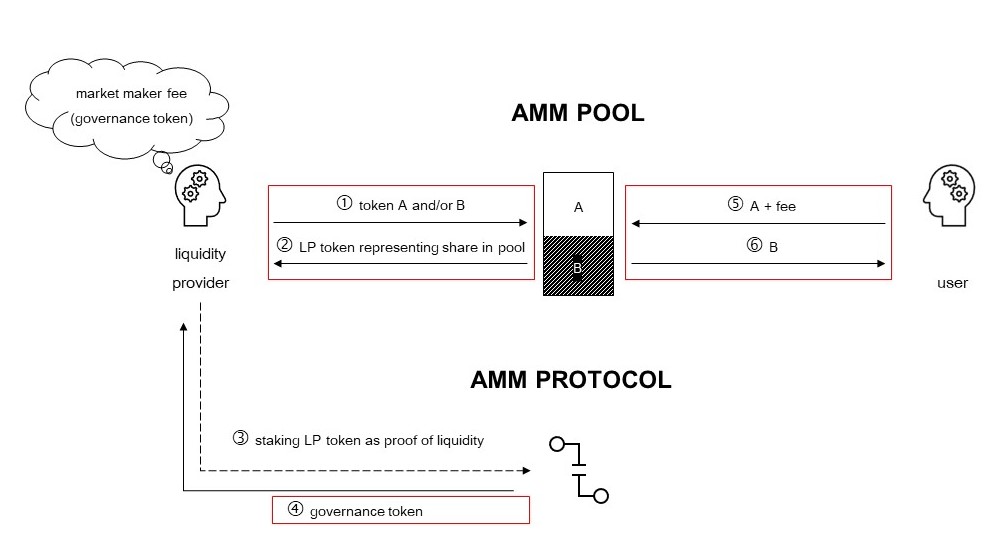
(Potentially) Regulated Activities
- exchange of crypto asset with LP token (1)(2) >> crypto asset exchange service -/
- exchange of crypto assets (5)(6) >> crypto asset exchange service -/
- safekeeping of deposited crypto assets in smart contract controlling the AMM pool >> crypto asset exchange service in form of custody service +/-
- issuance of LP token (2) >> issuance of security +/-
- issuance of incentives (4) >> crypto asset exchange service similar to ICO -/
LENDING
To borrow funds via one of the existing lending platforms, users must deposit crypto assets to the protocol. When supplying funds to the lending protocol, lenders receive a token representing their share in the lending pool. This token may be used as collateral when borrowing funds from the protocol.
Depending on the protocol, an additional token, typically in form of a governance token, may be issued to both the lender and borrower as an incentive to use the platform.
Borrowers pay interests to the protocol which either forwards them directly to the lender or releases them once the lender decides to unlock his funds from the protocol.
Examples
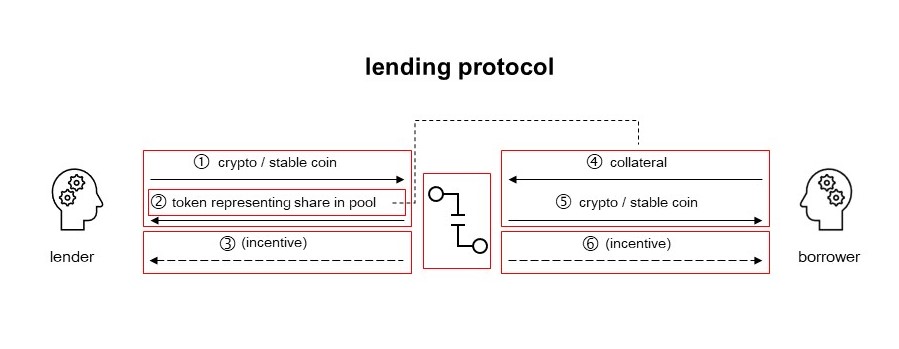
(Potentially) Regulated Activities
- exchange of crypto asset with token representing share in pool (1)(2) >> crypto asset exchange service +/-
- exchange of token representing share in pool with crypto asset (4)(5) >> crypto asset exchange service +/-
- safekeeping of deposited crypto assets in smart contract controlling the lending pool >> crypto asset exchange service in form of custody service +/-
- issuance of token representing share in pool (2) >> issuance of security /-
- issuance of governance tokens as incentive (3)(6) >> crypto asset exchange service /-
AGGREGATORS
Aggregators connect users, wallets, and smart contracts with liquidity. By doing so, they allow them to swap tokens for the best price available across multiple platforms.
Other aggregators constantly look for the best yield and distribute the supplied funds accordingly.
Examples
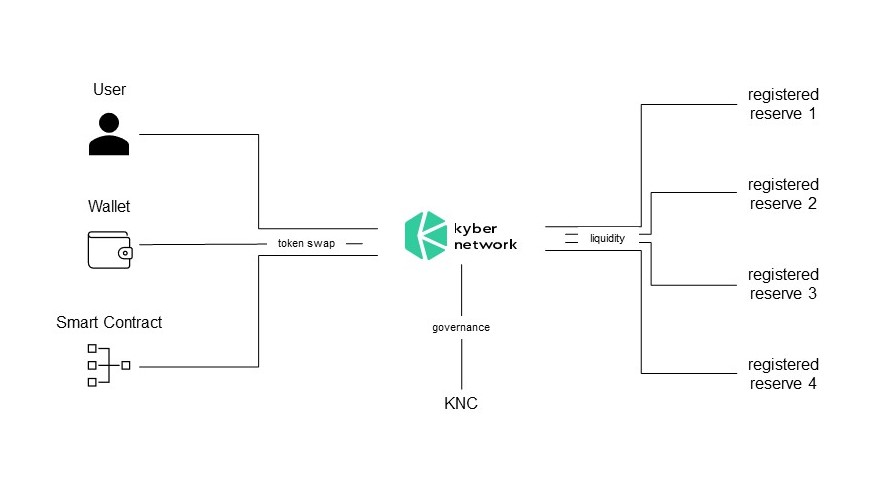
(Potentially) Regulated Activities
- intermediary services for the exchange of crypto assets >> crypto asset exchange service +/-
- search of and execution at best price >> investment advice -/
VAULTS
Vaults automatically optimize the returns on the funds supplied to them. To do so, they plug into multiple AMMs and lending protocols and move the funds wherever they generate the highest returns.
Where AMMs and lending protocols issue tokens as incentive, vaults automatically sell and reinvest them into the vault. One of the most prominent examples is yearn.finance.
Examples

(Potentially) Regulated Activities
- deposit of y LP token to vault (3) >> crypto asset exchange service in form of custody service /-
- allocation of crypto assets to pools with highest yield >> investment advice /-
DERIVATIVES
Derivatives platforms allow users to speculate and hedge their positions. For efficiency and cost reasons exchanges such as dydx use a hybrid off-chain/on-chain solution. The order book and order matching is performed off-chain while the margins paid by users of the platform are maintained by the protocol on-chain.
The infrastructure most derivatives exchanges operate on is similar to that of DEXes.
Examples
(Potentially) Regulated Activities
- order book/order matching >> financial instrument business operator license +/-
- deposit of margin to smart contract managing deposited funds >> crypto asset exchange service +/-
DISCLAIMER
THIS DOCUMENT IS FOR GENERAL INFORMATION purposes only. It does not constitute legal advice; thus, it may not be relied upon regarding a specific legal issue or problem. The projects mentioned in this document are used for illustrative purposes only. Given the format of the document not all details of the token design and underlying business model have been considered, so that the results of the assessment may deviate from the results by the regulator or a legal opinion prepared for the respective project.

Crypto derivatives have become increasingly popular and account for over 90 percent of the total trading volume in Japan. Internationally, crypto derivatives have gained increasing traction as well. Only in June, Deribit reported that BTC options on the exchange have reached a new all-time high with a total of USD 1.4 billion open interest. Almost at the same time, the daily exchange volume of CME bitcoin futures reached USD 1.3 billion.
The success of crypto derivatives has also caught much attention in the DeFi space. Projects such as dydx try to replicate the success of their peers while giving users more control over their funds.
Before diving into derivatives on dydx, namely perpetual futures, we will first explain how perpetuals work. In the second part, we will then analyze each step from the deposit of margins to the trading of derivatives in more detail.
Key Findings
| Derivatives exchange services | Crypto derivatives are financial instruments. A platform providing exchange services must therefore generally register as a type I financial instruments business operator. This may not apply for completely decentralized platforms without an operator. |
| Deposit of margin | Deposit-taking activities may be considered a crypto asset exchange service that must be registered with the FSA. This applies to both centralized and – depending on the functionality of the smart contract and admin rights – decentralized projects. |
| Derivatives transactions | Platforms themselves do generally not engage in crypto derivatives transactions directly. They do therefore not have to register as a financial instruments business operator with the FSA in respect to the trading activities. Despite providing liquidity on exchanges, users do generally not have to register with the FSA. In most cases, their activities are likely considered proprietary trading which is unregulated. |
From forward contracts to futures to perpetuals
One of the best ways to understand perpetuals is to look at forward contracts and standard futures first.
Forward contracts: Forward contracts are bilateral agreements according to which the parties trade a specified quantity of a particular good at a certain price at a predefined date in the future. The contract is typically negotiated between the parties and tailored to their needs. A unilateral transfer of rights and obligations is generally not possible.
Futures: Futures are similar to forward contracts in that they also concern the trade of a specified quantity of a particular good at a certain price at a predefined date in the future. Unlike forward contracts, futures are however highly standardized and traded on exchanges. For trades on the exchange, the exchange becomes the buyer to each seller and the seller to each buyer. The users of the exchange therefore only bear the counterparty risk of the exchange but not the default risk of the other party.
Perpetual contracts: Perpetual contracts – for the large part – are perpetual futures, i.e. futures without a maturity date. Often provided via offshore jurisdictions, they allow traders to get leveraged exposure to bitcoin or other crypto assets. Typically, the margin requirements are 1 percent of the contract value for the initial margin and 0.75 percent for the maintenance margin. Where the margin falls below the prescribed thresholds, the position is automatically liquidated by the exchange. In some cases, the position is completely liquidated at once. In other cases, the liquidation occurs incrementally.
To ensure that the price of perpetuals does not deviate too much from the index price of the underlying asset, perpetual contracts use a certain funding mechanism. Where the perpetual contract is traded above the index price of the underlying asset, the trader holding the long position must pay the difference to the trader holding the short position and vice versa. Funding payments are calculated in regular intervals. In some cases, these intervals only account for milliseconds.
Most exchanges maintain an insurance fund to cover losses from bankrupt traders. Only if the insurance fund is depleted, losses from bankrupt traders are socialized.
| Criterion | Collateral | Futures | Perpetuals |
| Buyer-seller interaction | Direct | Via exchange | Via exchange |
| Contract terms | Can be tailored | Standardized | Standardized |
| Unilateral reversal | Not possible | Possible | Possible |
| Default-risk borne by | Individual parties | Exchange | Individual parties |
| Default controlled by | Collateral | Margin accounts | Margin accounts and insurance fund |
Perpetuals on dydx
Perpetuals traded on dydx are not different from perpetuals traded elsewhere. Unlike other platforms dydx uses a different approach for the trading and settlement, however, by utilizing a hybrid on-chain/off-chain approach.
While the order book and the order matching is off-chain, all other actions are performed by smart contracts on-chain. These smart contracts are either developed by dydx or third parties (e.g. MakerDAO BTC-USD Oracle). Some of them have backdoors for administrators.
According to dydx, the hybrid solution is meant to combine the best of both worlds, i.e. off-chain speed and efficiency, and on-chain security.
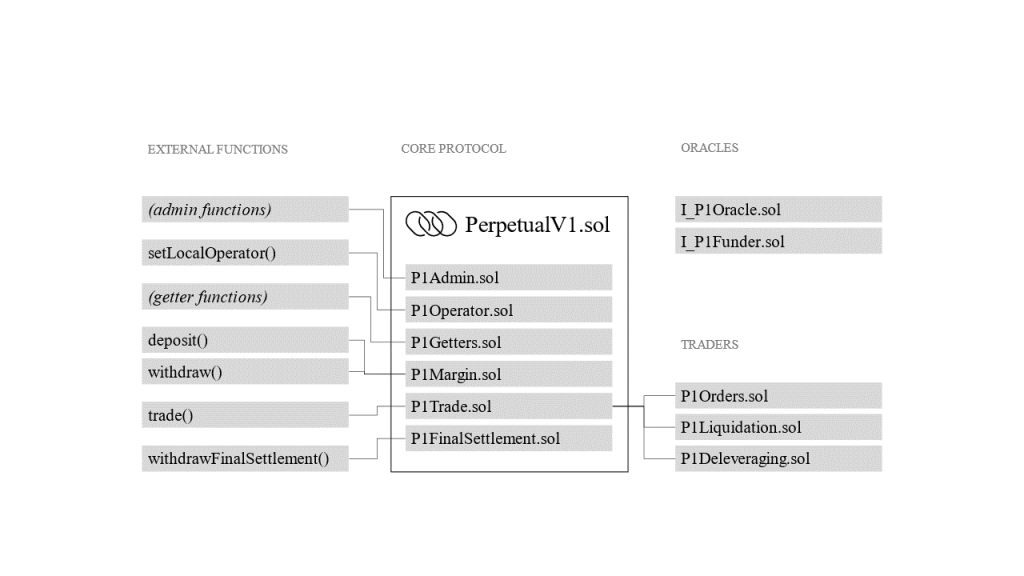
In order to trade on dydx users have to pay a margin to dydx’s protocol. If the margin falls below the maintenance margin, an account may be liquidated. In the liquidation process anyone may assume the margin and position balances of the liquidated account, provided of course, he has sufficient margin on his own.
Where an account falls short and has a negative net value the admin of the perpetual smart contract or a third party can call an offsetting account to take over the balance. This account is typically the insurance fund maintained by dydx. If the insurance fund is depleted, the admin may determine another account with a high amount of profit and margin to take over the balance.
Regulations in Japan
From a regulatory point of view, there are three different activities that must be assessed independently: (i) exchange services for derivatives, (ii) safekeeping of the margin, and (iii) engaging in derivatives transactions.
Trading Platform
Crypto derivatives platforms are generally not considered financial instruments markets under the Financial Instruments and Exchange Act (FIEA). Yet, it is still necessary to register as a type I financial instruments business operator (FIBO) when operating a platform. This also applies to entities that use hybrid solutions, i.e. an off-chain order book and matching engine combined with on-chain settlement. The hybrid solution of dydx, for example, would be subject to registration requirements.
Something different may apply where the order book and matching engine are on-chain and where there is no operator. The smart contracts should further not be controlled by the project’s developers. Projects that have originally controlled the entity but subsequently transferred control to the community may not be covered by the registration requirement anymore. Where the project team remains the majority owner of the governance tokens, it may still be seen as the operator of the platform. A careful analysis is therefore necessary.
Deposit of Margin
Users who wish to trade perpetuals must generally deposit a margin. This applies to both centralized and decentralized platforms, whereas for the latter, the amount is not paid to the platform, but a smart contract deployed by the platform.
Typically, the margin is either paid in bitcoin or some other cryptocurrency or, as in the case of dydx, stable coins. While bitcoin and other crypto currencies constitute crypto assets under the Payment Services Act (PSA), stable coins must be analyzed more carefully. Depending on their design, stable coins may either be classified as crypto assets or money orders. The safekeeping of stable coins that are crypto assets is regulated as crypto asset exchange services as written below. Where stable coins constitute money orders, regulations do generally not apply to the safekeeping of stable coins in Japan.
The custody of crypto assets for others is generally considered a crypto asset exchange service under the PSA and must be registered with the Financial Services Agency (FSA). Since custody requires control over the crypto assets, services are not covered if a platform does not have ability to transfer a user’s funds. The fact that funds are locked into a smart contract does not automatically mean that the platform does not have control over the funds. In particular, where the platform is able to modify the smart contract in such a way that allows it to transfer the funds, the platform will still be deemed to have control. It is therefore necessary to analyze the administrator rights carefully, and where necessary to modify them to avoid registration.
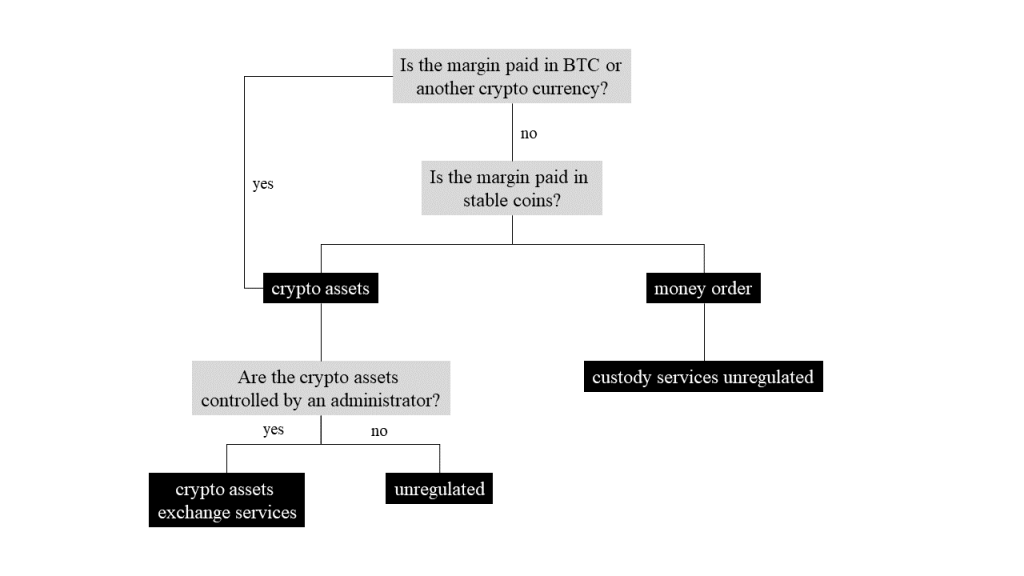
Derivatives Transactions
Crypto derivatives constitute financial instruments within the meaning of the FIEA. This applies irrespective of whether they are settled in fiat or cryptocurrencies. Entities engaging in derivatives transactions must therefore generally register with the FSA as a FIBO. An exception may however be made for entities engaging in transactions with certain counter parties.
Since crypto derivatives platforms do not engage in transactions with their users but only provide the marketplace, they must generally not register as FIBO with regard to entering into transactions as such.
For users something different might apply since they can act both as makers, i.e. liquidity providers, or takers. A registration is only required however if the respective person engages in derivative transactions in the course of their business. In general, the activities on the exchanges are more akin to proprietary trading which is unregulated. This applies irrespective of whether the trader acts as a maker or taker.
It should be noted that the provision of a leverage exceeding 2x to retail investors is not allowed under Japanese laws.
Conclusion
The principle “same business same rules” also applies to derivatives. DeFi and offshore projects may therefore be required to register with the FSA if they want to offer their services to users in Japan. For fully decentralized projects without an operator something different may apply. The law, at least, is silent in this respect and leaves room for interpretation. DeFi projects that have transferred control over the protocol to their users, may therefore decide to enter the Japanese market without registration. For other projects smart technical solutions backed by legal arrangements may ease the regulatory burden and should be considered.
If you want to learn more, please feel free to contact us any time.

With 24 registered crypto asset exchanges, the Japanese market has become increasingly competitive over the last few years. Constrained by regulations, Japanese exchanges have further only been able to list a fraction of the tokens traded elsewhere. At the same time, new restrictions on margin trading and additional license requirements for crypto derivatives have made it increasingly difficult to compete internationally.
The latest market developments, namely the shift from proof-of-work to proof-of-stake consensus mechanisms and the increasing popularity of yield farming, provide an excellent opportunity to exchanges, however, to add further services and to exploit additional revenue streams.
In this article, we analyze the regulatory environment for exchanges that want to use their customers’ funds for staking and yield farming services, highlight potential pitfalls, and provide some legal considerations for implementing these services.
For more information on the regulatory environment for DeFi lending platforms, please visit our previous article.
| KEY FINDINGS Registered exchanges can generally provide staking and yield farming services in Japan if they (1) remain in control over the staked funds and (2) do not transfer the economic risk resulting from staking and yield farming to their users. |
DEFINITIONS
Proof-of-Stake (PoS)
Blockchains depend on some form of consensus mechanism. The mechanism ensures that all nodes in the network agree on a single state and that the transaction history becomes immutable. The proof-of-work (PoW) consensus mechanism was the first successfully deployed. Given its high energy consumption and low transaction throughput, new consensus mechanisms have evolved. The most prominent is the proof-of-stake (PoS) consensus mechanism.
PoS generally uses a pseudo-random selection process to select a node as a validator. Selection criteria vary from platform to platform and include, among others, a node’s wealth, staking age, or other factors.
The validator of a block generally receives a block reward together with transaction fees paid by the users of a network. According to stakingrewards.com, the staking rewards for the bigger platforms are typically between 3-9 percent of the staked amount.[1]
While the Ethereum community has discussed the transition from a PoW to a PoS consensus mechanism for some time, other platforms have pressed ahead. Current forms range from pure PoS to different types of delegated PoS (DPoS). For the latter, a user does not directly participate in the validation of transactions but delegates this activity to others, the delegates.
Table 1: Overview of different consensus mechanisms using some form of PoS
| consensus mechanism | funds controlled by user | direct distribution to user | penalties | |
Ethereum 2.0 |
PoS |
yes, but temporarily locked in a smart contract |
yes |
yes |
|
|
tezos |
liquid PoS |
baking (PoS) |
yes, but locked in a smart contract as a bond |
yes |
yes |
|
delegating (DPoS) |
yes, different keys for transactions and staking |
no |
no |
||
|
EOS |
DPoS |
yes, but temporarily locked in a smart contract |
not necessarily any distribution to delegators |
no |
|
|
Algorand |
pure PoS |
yes |
yes |
no |
|
|
LISK |
DPoS |
yes, but temporarily locked |
no |
only lock-up for an extended period |
|
Yield Farming
Yield farming allows token holders to generate passive income from their crypto holdings as well. Instead of participating in staking, yield farming requires users to lock their funds into a lending protocol such as Compound or MakerDAO, which in turn allows others to borrow from the pooled funds at a certain interest rate.
Many of the lending protocols currently involve an additional type of token, which is used as an incentive for both lenders and borrowers. Together with these incentives, annual yields of up to 100 percent were possible until last month. More recently, the price of most governance tokens dropped, however, and brought the yield for lenders down to more realistic levels.
Currently, most DeFi lending activities focus on the Ethereum blockchain. Since Ethereum still uses the PoW, yield farming and staking do not compete directly. However, this will change with the roll-out of Ethereum 2.0 over the next five to ten years.
LEGAL CONSIDERATIONS
Registered exchanges in Japan can engage in the exchange of crypto assets and the management of their users’ funds – all, of course, within the boundaries set by the Payment Services Act (PSA) and subsidiary legislation.
Crypto Asset Exchange Services
The definition of crypto asset exchange services in the PSA does not only lay out the services subject to registration. It also determines the scope of regulated services a registered exchange may provide.
According to Section 2(5) PSA, the following services are considered crypto asset exchange services:
- the purchase and sale of crypto assets or exchange of crypto assets
- intermediary, brokerage, or agency services for the purchase, sale, and exchange of crypto assets
- the management of a user’s funds in relation to the purchase, sale, and exchange of crypto assets
- the management of crypto assets on behalf of another person
Since all exchanges in Japan are centralized exchanges, they provide exchange and custody services.[2] Accordingly, they must also follow the rules for crypto custodians when providing staking or yield farming services.
Custody Services
Under the new regulations, exchanges are generally required to hold 95 percent of their users’ funds in a cold wallet or secure them by means which provide a similar level of security. The remaining 5 percent can be stored in a hot wallet but must be fully backed by an exchange’s own funds.
It should be noted that in both cases, the exchange remains in full control over its users’ funds. A user is, therefore, generally able to withdraw his funds at any time. This even applies in cases similar to a bank run and must be borne in mind when preparing the terms and conditions for yield farming and staking services.
POS UNDER THE PSA
As shown above, PoS mechanisms come in different shapes and sizes. It is, therefore, necessary to analyze the design carefully when assessing the admissibility of staking services.
As much as the admissibility depends on the design of the respective consensus mechanism, it depends on the contractual arrangements in place. Both components and their interaction with each other must, therefore, be analyzed comprehensively. This applies in particular because the right contractual arrangements may neutralize some of the negative effects resulting from design choices.
Control Over Funds
The first thing to consider is who controls the staked funds. If it is the user, which is highly unlikely if not impossible in case of centralized exchanges, there are no concerns. The same is true if the funds are controlled and remain under the control of the exchange after being used for staking.
PoS
In most PoS models, a user must lock his tokens in a smart contract for staking. While the tokens are temporarily locked in the smart contract, i.e. the time they are used for staking and in some cases an additional period, they can generally be unlocked at any time.
The only one who can unlock the funds from the smart contract is the person controlling the private key corresponding to the address that was initially used to lock the funds in the smart contract. Except for slashing staked funds in case of misbehavior or excessive downtimes, the smart contract does not control the staked amount. In particular, it is not able to transfer the funds independently.
Since the funds remain under the control of an exchange, the situation is not different from any other situation where the funds are associated with an address controlled by an exchange.
DPoS
In the case of DPoS, the situation is generally not different from the situation described above. An exchange using funds for delegation services does not lose control over the funds at any time. This applies even if the funds are locked in a smart contract for delegation.
In some cases, namely the liquid PoS by tezos, the exchange must not even send a users’ funds to a smart contract. Instead, there are two keys – one for controlling the funds and another one for delegation. Unlike in other PoS models, it is therefore not even necessary to send the funds to a smart contract and withdraw them when a user wants to withdraw his funds from the exchange.
Hot Wallet VS Cold Wallet
Since the smart contracts used for staking do generally not control the locked funds, the situation is comparable to the situation where the funds are associated with an address controlled by the exchange. In both cases, the funds can only be transferred by the person controlling the private keys. If these keys are stored offline, the level of security is generally the same for funds locked in the smart contract and funds associated with an ordinary address. That being said, there is no reason to treat the two situations differently.
Liquidity Constraints
Most PoS consensus mechanisms require the user to lock funds into a smart contract. Even if the funds are unlocked, the holder of the private key may not receive the funds directly. An exchange staking its users’ funds may, therefore, not be able to respond to a withdrawal request immediately.
An exchange may either counter the delay by using its own funds or provide in its terms and conditions that there may be delays if a user also wants to use the exchange’s staking services. The terms may further lay out different periods for different protocols or simply use the longest period as a standard.
Economic Risks (Slashing)
Some PoS consensus mechanisms provide for slashing in case of misbehavior, excessive downtimes, or other violations of the protocol’s rules. In other words, the person violating the rules loses a certain amount of staked funds.
Where the economic risks and benefits are borne by the user, staking is more akin to investments than to deposits. Investment activities are, however, regulated under the Financial Instruments and Exchange Act (FIEA) and require a different license. A crypto asset exchange license is not sufficient.
Crypto asset exchanges that do not have the necessary licenses must, therefore, implement measures to prevent users from bearing the economic risk of staking. One way to do so is by reconciling losses with the exchange’s own funds.
YIELD FARMING UNDER THE PSA
The legal considerations are generally the same for PoS and yield farming. In short, an exchange may not carry out activities where the users run the risk of making a loss.
Compared to staking, there is one fundamental difference, however. An exchange will lose control over the lent amount. The control over the asset is transferred to the lending protocol, which in turn lends the funds to other users.
In exchange for supplying the funds to the protocol, an exchange does, however, receive another token which represents an increasing share in the protocol’s funds. By transferring these tokens to the protocol, an exchange can generally redeem the locked funds from a lending protocol at any time. This applies at least if there is sufficient liquidity. In the case of illiquidity, an exchange may have to wait for a certain amount of time until the redemption may be completed. An exchange may bridge this time either by using its own funds or putting a contract in place that allows it to wait with the refund until there is sufficient liquidity on the respective market.
The private keys controlling the tokens issued by the protocol can be stored in a cold or hot wallet like any other key in possession of the exchange. Insofar, nothing different applies.
CONCLUSION
The PSA does not generally prohibit yield farming or staking services. This applies at least if the economic risks of staking or yield farming are not transferred to the user. It is also necessary to take a closer look at the respective PoS mechanism and adjust, where appropriate, the contractual documentation.
With respect to yield farming, it should be noted that DeFi lending has been prone to exploits by flashloans. Exchanges that wish to enter the space are therefore well advised to analyze potential attack vectors carefully.
Given the current vulnerabilities of DeFi protocols, we expect that only staking services will get more traction in the near future. Yield farming will, however, follow in the mid- to long term. If you want to discuss the technical and legal implementation of PoS and staking services, please feel free to contact us at any time.
[1] Staking Rewards, Trusted Data. Stakeable Assets., retrieved from https://www.stakingrewards.com/proof-of-stake (accessed on 03/08/2020).
[2] Unlike decentralized exchanges, centralized exchanges require users to transfer their funds to an address controlled by the exchange. The user does not have any control over the funds until he instructs the exchange to transfer the funds to an address specified by him.

Mostly unrecognized by mainstream media, DeFi has gained increasing traction over the last few months. Large parts of its growth can be attributed to lending platforms such as Compound, Maker, and Aave, just to name a few. Broadly speaking, users of these platforms receive some form of interest in exchange for locking their assets into a smart contract, which in turn lends them to (other) users. Together with extrinsic rewards paid by these platforms, yields of up to 100 percent are currently possible. The process of optimizing yield through a combination of leverage and rewards is commonly referred to as yield farming and liquidity mining.
In this article, we will discuss the regulatory treatment of lending platforms under Japanese laws. Restrictions for users do not exist. In our next article, we will focus on the opportunities, Compound and other platforms provide to crypto asset exchanges in Japan, which currently face fierce competition and pressure under the new regulations.
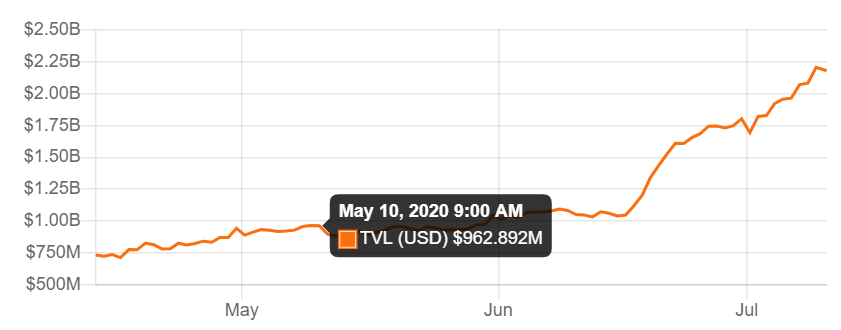
The chart includes data from DEX, lending, derivatives, payments, and assets platforms.
1. The Concept
The basic concept of yield farming and liquidity mining is to generate passive income from crypto assets. Yield farmers and liquidity miners generally try to put their assets to maximum use by utilizing a combination of lending and borrowing techniques on one or more lending platforms. Apps such as Instadapp help users to bridge different protocols and to leverage the full potential of DeFi by automating large parts of the lending and borrowing activities.
To explain how yield farming and liquidity mining work, we will use Compound, one of the biggest and currently most used platforms, as an example.[1]
1.1 Lending
In order to earn a yield on Compound, users must lock their assets in a smart contract. In turn, the smart contract issues new tokens (cTokens) at a predefined exchange rate. These tokens allow the user to earn a yield over time and to use them as collateral when borrowing funds via the platform.
cTokens do not provide recurring revenue to their holders. Instead, they represent a share in a pool of assets that constantly grows due to borrowers’ interest payments. With the price of cTokens increasing relative to the locked assets, cTokens generate a yield when used to withdraw the locked assets. The actual amount depends on the compound interests calculated by the protocol based on market dynamics, namely supply and demand.
In addition to the compound yield, lenders currently receive COMP tokens. These tokens allow their holders to propose and vote on changes to the protocol and are actively traded on exchanges. Only with COMP tokens, the current yields are possible at all.

1.2 Borrowing
When borrowing funds via Compound, a user must deposit cTokens as collateral. The maximum amount a user can borrow depends on the collateral factor of the deposited asset. This factor is set by COMP token holders. The collateral factor is generally higher for liquid, high-cap assets and lower for illiquid, small-cap assets. The collateral factor of ETH, for example, is currently set at 0.7. A user supplying ETH 100 to the protocol, would therefore be able to borrow up ETH 70 worth of assets via Compound.[3]
Where a user’s borrowing balance exceeds his borrowing capacity due to outstanding interests, the value of collateral falling or the borrowed assets increasing in price, the collateral will be liquidated automatically at a discount to the current market price.
Like lenders, borrowers currently receive an external reward in the form of COMP tokens for using the Compound platform. Every day, approximately 2,880 COMP are distributed – 50 percent to lenders and 50 percent to borrowers.
2. Regulatory Environment
When analyzing the legal and regulatory environment for DeFi lending activities, it is necessary to break down the lending model into different components. First, it is necessary to analyze the tokens required for the protocol to work. In a second step, the activities involving each of the tokens must be analyzed in more detail. It should be noted, however, that it is not possible to view tokens and activities as separate components, but that it is necessary to consider the interaction between both for the analysis.
2.1 Legal Classification of the Tokens
Compound and other lending platforms involve a number of different tokens. In the case of Compound, these tokens are (i) ETH and ERC-20 tokens supplied to the protocol, (ii) cTokens which are issued in exchange for the tokens supplied, and (iii) COMP which is issued as a reward and which constitutes the protocol’s governance token.
Under Japanese laws, tokens may either constitute crypto assets under the Payment Services Act (PSA) or electronically recorded transfer rights under the Financial Instruments and Exchange Act (FIEA). Tokens neither covered by the definition of crypto assets nor electronically recorded transfer rights may not be regulated at all.
The PSA distinguishes between type I crypto assets and type II crypto assets. Type I crypto assets are proprietary values that can (i) be used for purchasing goods and services from unspecified persons, (ii) purchased from and sold to unspecified persons acting as counterparties, (iii) and transferred electronically.
Type II crypto assets are property values that can (i) be mutually exchanged with unspecified persons for type I crypto assets and (ii) transferred electronically. Currency denominated assets such as fiat currencies and electronically recorded transfer rights are explicitly excluded from the definition of both type I and type II crypto assets.
The definition of electronically recorded transfer rights was added to the FIEA with the latest amendment. It covers electronically recorded values that represent type II securities which can be transferred electronically, and which do not have liquidity constraints.
2.1.1 ETH and ERC-20 Tokens
Currently, most platforms, including Compound, allow users to deposit ETH, certain ERC-20 utility tokens[4], and different kinds of stable coins.
ETH is a typical type I crypto asset. ERC-20 utility tokens generally constitute type II crypto assets as they can easily be exchanged with type I crypto assets. The same most likely applies to wrapped bitcoin as they are currently not used for payment and can only be exchanged with type I crypto assets.
For stable coins, the legal classification depends on their exact features and underlying model. The most prominent stable coins, such as USDT and USDC, are based on an IOU model. Each token is backed by one USD.[5] As a result, they are likely to fall under the definition of currency denominated assets and are thus excluded from the definition of crypto assets under the PSA. For more information on the classification of different stable coins, click here.
2.1.2 cTokens
cTokens represent a user’s balance in the Compound protocol. As the market earns interest, the tokens become convertible into an increasing amount of the underlying assets. This raises questions as to whether cTokens represent beneficiary certificates in a money market fund (MMF) or interests in a collective investment scheme and therefore constitute electronically recorded transfer rights.
Beneficiary Certificates in an MMF
Traditionally MMFs are used as cash management vehicles for retail and institutional investors. Defining features are the payment of dividends, the fact that investors can redeem their certificates at any time, and the fact that MMFs seek to maintain a stable net asset value. The redemption of a substantial amount of beneficiary certificates may, however, result in a loss of liquidity and negatively affect the remaining certificates’ price.
The risk of illiquidity also exists in the case of Compound and other DeFi protocols. As the following graphic shows, it may be even more pronounced than for traditional MMFs.
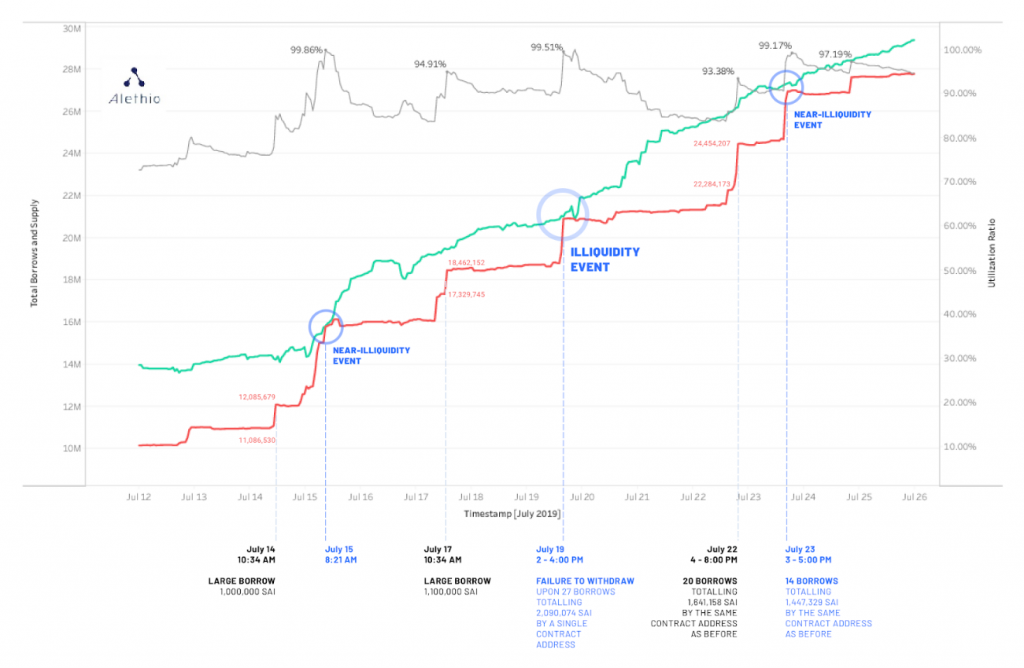
The green line indicates the total amount of SAI supplied, the red line the total amount of SAI borrowed, and the grey line the utilization ratio.
The difference between Compound and traditional MMFs is that a user’s yield is independent of profits generated by the protocol. Rather than calculating the yield after repayment of the borrowed loans, the protocol uses the prevailing interest rate for each interval when calculating the compound interest rate. Whether a loan is fully paid back at any point in time or not, is irrelevant
It is further worth noting that the Compound protocol does not constitute a legal entity that could act as a trust. The protocol is also not controlled by a legal entity that may otherwise be seen as a principal.
Interests in a Collective Investment Scheme
The definition of collective investment schemes in the FIEA[7] is intentionally broad and covers various arrangements that are used to pool money for investment purposes. Investors in a collective investment scheme are entitled to participate in the earnings a scheme generates but bear a business risk at the same time. If the scheme suffers a loss, investors in the scheme suffer a loss as well.
The argument that Compound and other DeFi platforms do not pay dividends can also be used with regard to collective investment schemes. Unlike investors in a collective investment scheme, holders of cTokens earn a yield irrespective of profits generated by the platform. The yield solely depends on the accrued interests over time and is calculated by using the interest rate on the respective markets for each block.
While there is an illiquidity risk, lenders should generally not make a loss when using Compound. This is due to the over-collateralization and auto-liquidation of loans where the balance of the collateral is insufficient to support the loan. If this promise holds true, the situation is fundamentally different from collective investment schemes where investors may actually suffer a loss.
It may further be argued that cTokens do not fall under the definition of interests in a collective investment scheme as they do not represent rights. Rights, by definition, require a counterparty. In the case of DeFi, a counterparty does not exist. Instead, assets are collected and distributed via smart contracts according to predefined rules on a factual basis. Whether the regulator will follow this argument remains to be seen. Yet, we believe that there is plenty of room to argue that cTokens and similar arrangements do not fall under the definition of collective investment schemes and do, therefore, not constitute electronically recorded transfer rights under the FIEA.
Type II Crypto Assets
Since cTokens can be transferred electronically and exchanged with other tokens, they represent type II crypto assets under the PSA. The fact that the tokens become convertible into an increasing amount of the underlying asset does not lead to different results. This is because their value is only driven by market forces, namely supply and demand. The protocol merely ensures that the value of cTokens does not decrease relative to the underlying asset over time.
2.1.3 Governance Tokens
Governance tokens issued by the Compound protocol constitute type II crypto assets. They can be exchanged with other crypto assets but are not used for payment. The fact that governance tokens provide the user with voting rights is irrelevant for the legal classification in the absence of other features.
2.2 Legal Classification of Activities
2.2.1 Lending and Borrowing of Crypto Assets
The lending and borrowing of crypto assets are not regulated under Japanese laws. A banking license or money lending license is therefore not required.
2.2.2 Exchange with cTokens
The exchange of crypto assets is generally considered a crypto asset exchange business in Japan. This applies irrespective of whether the exchange is facilitated by a centralized exchange, a decentralized exchange (DEX),or another smart contract if there is a controller.
Whether the issuance of cTokens in exchange for the supply of other tokens constitutes an exchange within the meaning of the PSA is not clear. Neither the PSA nor any subsidiary legislation contains a definition of exchange. Yet, there are good reasons to doubt that the issuance of cTokens in exchange for the supply of other tokens constitutes an exchange within the meaning of the PSA and must, therefore, be registered with the Financial Services Agency (FSA).
cTokens are issued when a user supplies other tokens to the protocol. While this might look typical exchange of crypto assets, there is a fundamental difference. The user does not lose control over the initial amount deposited. cTokens more or less serve as a key to unlock the initial amount deposit and can be used at any time to do so – provided of course, there is sufficient liquidity. For typical exchanges, this possibility does not exist. The same applies to the exchange of cTokens for other crypto assets.
2.2.3 Issuance of Governance Tokens
The issuance of governance tokens is not an exchange business as well. While the issuance of tokens in exchange for liquidity, is sometimes compared with ICOs the key difference is that there is no payment of consideration for receiving the tokens. Instead, the tokens are issued as a subsidy by the platform without additional consideration. It is therefore more akin to an airdrop where an issuer aims to promote his platform. Also, in these cases, it is not necessary to register as a crypto asset exchange.
2.2.4 Locking of Tokens into Smart Contract
The definition of crypto asset exchange services also includes custody business. When tokens are locked into a smart contract, this may generally be considered custody under the PSA. It may however be argued that this does not apply where the smart contract creator does not have control over the contract. In these cases, only the user is able to unlock the supplied amount by transferring cTokens to the smart contract and to release the funds. The automatic liquidation function does not change this result as the protocol creator does not have control over the funds at any point of time.
Conclusion
While DeFi has become increasingly popular over the last few months, it has not been on the radar of Japanese regulators so far. The good news is that certain protocols and tokens will most likely not fall under the FIEA. This will hopefully allow DeFi to get some more traction on the Japanese market and allow exchanges to add DeFi to their services.
As so often, the devil is in the detail. Much depends on the structure of the overall arrangement and the token design. Existing projects that intend to enter the Japanese market are therefore well advised to analyze their protocol and token design carefully.[8] The same applies to crypto asset exchanges that intend to add further services in the future to become more attractive in an increasingly competitive market.
We will analyze the possibilities resulting from DeFi and PoS for exchanges in our next article. Stay with us.
DISCLAIMER
The DeFi protocols mentioned in this article, in particular Compound, are used for illustrative purposes only. Given the format of the article, not all details of the protocol and token design have been considered comprehensively, so that the results of the assessment may deviate from the results by the regulator or a legal opinion prepared for the respective project. By no means, the explanations should be understood as a legal opinion regarding DeFi protocols mentioned in this article.
[1] According to DeFi Pulse, 28.03 percent of the USD 2.51 billion total value locked in DeFI is currently locked in Compound, DeFi Pulse, retrieved from https://defipulse.com/ (accessed on 10 July 2020).
[2] Compound, retrieved from https://compound.finance/ctokens (accessed on 10 July 2020).
[3] It is worth noting that a user’s collateral would immediately be liquidated to a certain extent with the first interest payment becoming due.
[4] For this paper, utility tokens are understood as tokens that give token holders access to an application or a service and which serve as a platform-internal currency.
[5] For USDT, the accounts have not been properly audited so far.
[6] Alethic, Illiquidity and Bank Run Risk in DeFi, retrieved from https://medium.com/alethio/overlooked-risk-illiquidity-and-bank-runs-on-compound-finance-5d6fc3922d0d (accessed 10 July 2020).
[7] Article 2(2)(v) FIEA.
[8] DeFi, by definition, does not necessarily involve a central entity controlling the project. It may, therefore, be difficult for the regulator to get hold of the persons behind the project. If a project aims to get more traction in the regulated space, there is however no way to cut some corners or to circumvent regulation altogether.

An overview of the latest amendment to the Japanese crypto regulations. The changes entered into force on May 1, 2020 and affect cryptocurrency exchanges, custodians, crypto derivatives, and security token offerings (STOs).
The following presentation provides a high level overview.
Crypto_Law_Amendment(JP)_200427
Crypto_Law_Amendment(EN)_200424
For a more detailed explanation please visit our article on digital assets.

Starting with Bitcoin in 2009, crypto assets have come a long way. Now, more than ten years later, the ecosystem is more diverse than ever, and bitcoin and other crypto assets are on the verge of becoming a new asset class. At the same time, blockchain technology has made significant progress and evolved from a pure state transition system to fully programmable networks. 2nd and 3rd generation networks allow other projects to build dApps on their platform and to deploy smart contracts to issue their own tokens. With the rise of these platforms, Initial Coin Offerings (ICOs), Initial Exchange Offerings (IEOs), and Security Token Offerings (STOs) have become a popular mechanism to raise funds. The flexibility offered by 2nd and 3rd generation networks also opened up new possibilities for more complex applications such as DeFi.
The potential of blockchain technology has also been recognized by governments around the globe. Experiencing pressure from projects such as Libra, some of them have intensified their research on central bank digital currencies and other blockchain applications.
While the industry is increasingly professionalized, major hacks exposed vulnerabilities in the existing infrastructure. Money laundering is another concern for policymakers. In view of these challenges and an increasingly diversified environment, the Japanese legislator amended the Japanese crypto regulations and published subsidiary legislation more recently. The changes are entering into force on May 1, 2020.
In this article, we take a closer look at the regulatory treatment of different digital assets, analyze the primary and secondary markets for them and provide an overview of different players in the industry, reaching from exchanges to liquidity providers and custodians.
Our article does not consider the current regulatory environment. For more information on the existing framework, please visit our older articles, which can be found here.
1. DIGITAL ASSETS
There is no general definition of digital assets under Japanese laws. Rather, the Payment Services Act (PSA) and the Financial Instruments and Exchange Act (FIEA) define certain types of digital assets. The definitions are mutually exclusive and – seen as a whole – form a complete picture covering cryptocurrencies, utility tokens and investment tokens.[1] Non-fungible tokens (NFT) and stable coins[2] are not necessarily covered by the definitions in the PSA and the FIEA.
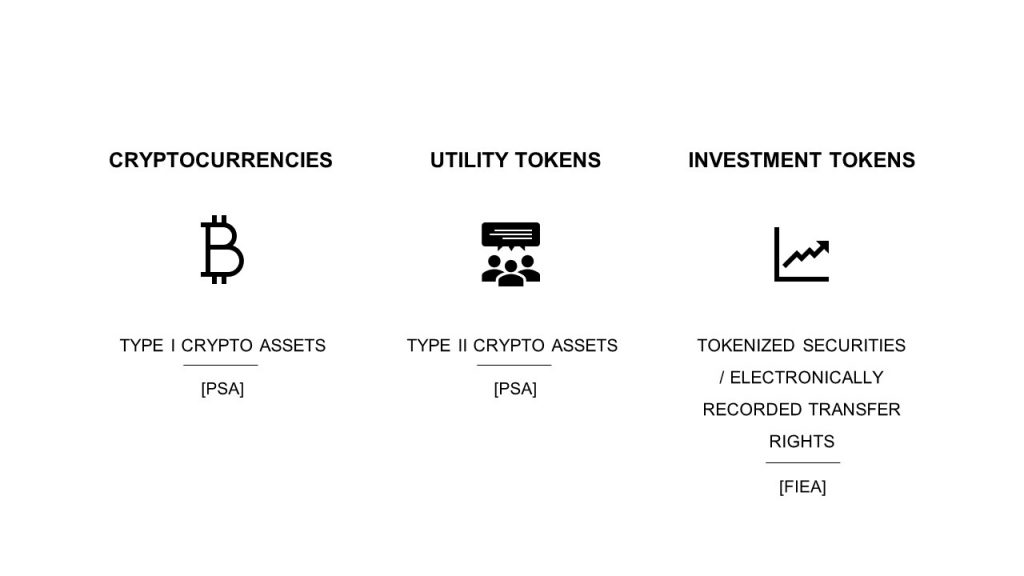
1.1 Crypto assets under the PSA
The PSA defines crypto assets exhaustively. Type I crypto assets are defined as property value that can be (i) used with unspecified persons for purchasing goods or services, (ii) purchased from and sold to unspecified persons acting as counterparty, and (iii) transferred electronically.[3]
Type II crypto assets are property values that can be (i) mutually exchanged with type I crypto assets with unspecified persons acting as a counterparty and (ii) transferred electronically.[4]
Currency denominated assets and electronically recorded transfer rights as defined in the FIEA are explicitly excluded from the definition of crypto assets.[5]
Type I crypto assets: cryptocurrencies
Type II crypto assets: utility tokens
1.2 Electronically recorded transfer rights under the FIEA
For a better understanding of electronically recorded transfer rights, it is worth looking at the definition of securities under the FIEA. The FIEA contains a comprehensive list of securities and distinguishes between type I and type II securities. Type I securities are traditional securities such as bonds and stocks, which are generally perceived as being highly liquid.[6] Type II securities are, for example, units in a fund, beneficial interests in a trust, membership rights in a general partnership or limited partnership, and equity in limited liability companies.[7] These securities are generally much less liquid than type I securities and are therefore subject to lighter regulation. With the occurrence of tokenization, type II securities became, however – at least in theory – much more liquid. As a response, the legislator introduced electronically recorded transfer rights into the FIEA. These rights represent type II securities which are treated as type I securities.[8]
The FIEA defines electronically recorded transfer rights as (i) electronically recorded property values that (ii) represent type II securities and can be (iii) transferred by electronic means. In addition, (iv) there must not be any liquidity constraints or other circumstances specified by cabinet order.[9] Tokens that are sold to professional investors and for which the transferability is technically restricted, fall under the exemption of item (iv).[10]
Tokens representing type I securities are not covered by the definition of electronically recorded transfer rights and are therefore not excluded from the definition of crypto assets.[11] According to unofficial statements, the Financial Services Agency (FSA) considers type I securities as currency denominated assets, however, which are excluded from the definition of crypto assets as well.
1.3 Crypto derivatives
Crypto derivatives such as CFDs, futures, options, and swaps have become increasingly popular more recently. Some of them are said to legitimize crypto assets as a whole and to provide additional liquidity to crypto markets. In Japan, crypto derivatives account for roughly 90 percent of the total crypto trading volume.[12]
Crypto assets as defined in section 1.1 above are financial instruments within the meaning of the FIEA.[13] Derivatives using crypto assets as underlying or crypto asset indices as reference indices are therefore covered by the FIEA.[14] The FIEA distinguishes between derivatives transactions conducted on financial instruments market and OTC derivatives transactions.
Market derivatives transactions include[15]
- futures
- index futures
- options
- swaps
OTC derivatives transactions include[16]
- forward contracts
- index forward contracts
- options
- index options
- swaps
Excursion – Physical Settlement and Crypto Asset Exchange License
Crypto assets are deemed money under certain provisions of the FIEA.[17] Derivatives transactions may therefore be settled in cash or physically, i.e. by using crypto assets for settlement. The guidelines for crypto asset exchanges explicitly state that a crypto asset exchange license is not required in such cases.[18] In cases of margin trading where crypto assets are taken as collateral, something different might apply.
2. PRIMARY MARKETS
Tokens are often used for fundraising purposes. In this section, we take a closer look at fundraising via initial coin offerings (ICOs), initial exchange offerings (IEOs), and security token offerings (STOs).
2.1 Utility tokens
The offering of utility tokens for fundraising purposes is commonly known as ICO. Under the PSA, the offering of new tokens in exchange for fiat or cryptocurrencies is considered a crypto asset exchange service.[19] An issuer must therefore either register as a crypto asset exchange service provider[20] or sell his tokens via one of the registered exchanges. In the latter case, the exchange may either act as an intermediary or buy and sell the tokens on its own account.[21]
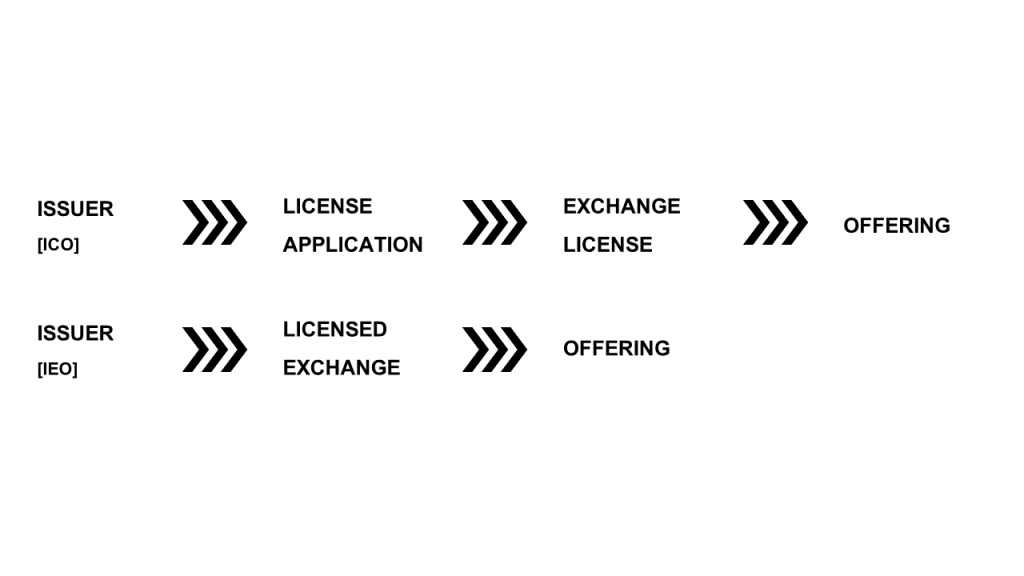
Excursion – Registration as crypto asset exchange
To register as a crypto asset exchange, companies must meet certain criteria. Local companies must be incorporated as a stock company[22] and have a minimum capital of JPY 10 million[23]. An exchange must further ensure that its net assets do not fall below the amount of users’ funds that are stored in a hot wallet.[24]
Aside from this, crypto asset exchanges must implement corporate governance and security systems that ensure fair dealing on the exchange and reduce operational risks.[25] The latter includes the separation of funds – both for crypto assets[26] and fiat currencies[27] – and the proper management of users’ funds held by the exchange (for more details, see section 4.1 below). Crypto asset exchanges violating their obligations under the PSA are subject to fines of up to JPY 3 million.[28]
While foreign crypto asset exchanges are generally able to register and operate in Japan, none of the 23 registered exchanges is currently a foreign exchange.[29]
2.1.1 Self-offering
Under the ICO regulations of the Japan Virtual Currency Exchange Association (JVCEA), an issuer who has successfully applied for a crypto asset exchange license must analyze its internal control and the feasibility of the target business comprehensively before launching its ICO.[30] The analysis must be based on certain documents, including the issuer’s financial statements, material agreements, business plan, whitepaper, and other documents deemed necessary by the issuer.[31] The results of the analysis must be submitted to the JVCEA for final review.[32] Only if the JVCEA does not raise any objections, the issuer may launch its ICO in Japan[33] after giving notice to the FSA[34].
When selling tokens to the broader public, an issuer must disclose a wide variety of information to the public in order to allow investors to make an informed decision. This includes among others:[35]
- information on the issuer
- information on the tokens and the token sale (incl. pricing information, incentives, sales period, token allocation, caps, future distributions)
- information on the use and the accounting treatment of the raised funds
- information on the project
- governing law and jurisdiction
Once the ICO is completed, the issuer must provide token holders with sales data, including information on the number of tokens issued and the total amount collected.[36] Token issuers are further subject to ongoing disclosure and must publish data about the status of the project and market value of the tokens at regular intervals.[37] This generally applies for a period of five years unless the protection of users is not compromised, and the issuer has informed the JVCEA.[38]
An issuer may not use the raised funds for any other purpose than disclosed to investors during the ICO[39] and must manage them separately from its other funds[40]. The private key controlling the raised funds must generally be stored offline.[41] The issuer must further establish an internal control system to prevent the misappropriation of funds by its officers and employees or the theft by third parties.[42]
2.1.2 IEO
Registered exchanges that allow other projects to launch their token offerings via their exchange must implement internal control systems to safeguard investors from investing in projects which are not feasible or an outright scam.[43] At the same time, they must ensure that the token issuer has systems in place to prevent inappropriate solicitation of the token sale or the misappropriation of funds.[44]
When assessing whether a token offering can be launched via its platform, an exchange must consider the issuer’s financial situation. To do so, an exchange must review the financial statements of the token issuer and, if possible, conduct a hearing with a certified accounting or auditing firm.[45] The sales price of the newly issued tokens must be determined in accordance with reasonable valuation methods (e.g. surveys on investment demand).[46] Registered exchanges must also ensure that the raised funds do not exceed the amount which is determined in the business plan of the issuer.[47] The results of the overall assessment must be submitted to the JVCEA for final review.[48] If the JVCEA finds that the offering is not feasible, the exchange must not proceed.[49]
To ensure that the trading of tokens is safe, exchanges must audit the smart contract and the blockchain protocol before launching the token sale.[50] The duty to ensure safety does, however, not end with the token sale. Rather, exchanges are required to monitor the system on an ongoing basis and report vulnerabilities to the JVCEA.[51]
Before offering new tokens on their platform, cryptocurrency exchanges must further publish certain information on their homepage. This information is largely identical to the information indicated in section 2.1.1.[52] Following the offering, the cryptocurrency exchange must ensure that the issuer properly maintains the internal control systems and disclosure mechanisms.[53] This does not apply if five years have passed since the offering or where the exchange has informed the JVCEA that investor protection is not compromised if compliance is no longer monitored by the exchange.[54]
Note: If an issuer actively engages in the token sale, this might be considered a crypto asset exchange service by the issuer and trigger registration requirements under the PSA despite selling the tokens via a registered exchange.[55] Whether this is the case must be determined on a case-by-case basis considering the degree of engagement and other factors.
2.2 Security tokens
The solicitation of an offer to sell securities in Japan is generally regulated under the FIEA. The term is understood broadly and covers any communication which allows investors to decide whether to purchase or subscribe for the offered securities. While there is no bright-line test, providing information on the terms of an offering is a clear indication of solicitation. As a rule of thumb, the more granular the information, the more likely it is that the marketing is considered a solicitation. Offers via the internet are generally considered a solicitation to invest in securities if they are made through a website that is publicly accessible. The use of the Japanese language is not necessarily required. Only where investors from Japan are effectively excluded from participating in the offer, for example, by geo-blocking or a KYC-process, an offering is not considered a solicitation of an offer to sell securities in Japan. A disclaimer, according to which Japanese investors are excluded from the offer, is not sufficient on its own but may, in combination with other measures, prevent the FIEA to apply.
The FIEA distinguishes between public offerings and private placements, self-offerings, and offerings via intermediaries.
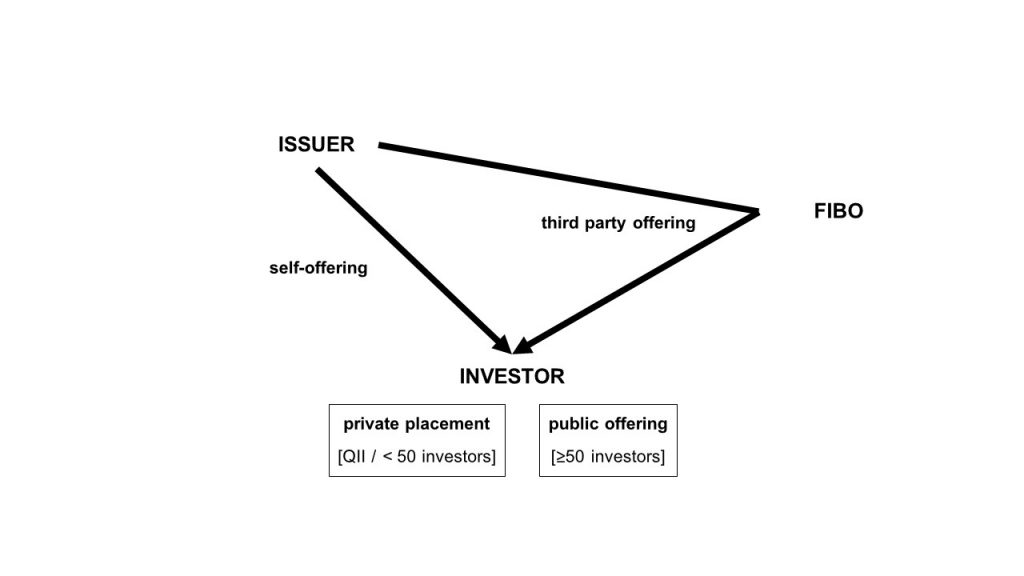
2.2.1 Public Offering
The offering of tokenized type I securities and electronically recorded transfer rights is considered a public offering if the tokens are offered to 50 or more investors.[56] Qualified institutional investors (QII) and professional investors as defined in the following section, are not considered when assessing the number of investors.
Public offerings with a total issue price of JPY 100 million (~ USD 915,000) or more must be registered with the FSA[57] and accompanied by a prospectus[58].
2.2.2 Private Placement
Offerings via private placements must not be registered with the FSA. Under the FIEA, the following offers are considered private placements[59]:
- offers to QII only where the transfer to persons other than QII is unlikely
- offers to professional investors only which satisfy all of the following requirements
- solicited party is not the state, the Bank of Japan (BoJ), or a QII
- solicitation by a Financial Instruments Business Operator (FIBO) on its own behalf or on behalf of a client
- transfer to persons other than professional investors is unlikely
3. offers to a small number of investors (< 50)
The definition of QIIs is rather extensive and consists of a long list of examples.[60] The list includes investment corporations, venture capital companies with a stated capital of JPY 500 million or more*, investment limited partnerships as well as special purpose companies*, other legal persons* and individuals* holding securities of at least JPY 1 billion.
Professional investors within the meaning of the FIEA are QIIs, the state, the BoJ, investor protection funds, and other corporations specified by cabinet order. The latter includes among others foreign corporations, specific purpose companies, and listed companies.
Tokens acquired in a private placement by QII or professional investors may not be resold to persons other than QII or professional investors as the case may be. If the tokens are resold in violation of the restrictions on resale, the issuer must file a registration statement with the FSA. This does not apply if the tokens are sold to a small number of investors and are subsequently resold by the initial investors to more than 49 persons.
2.2.3 Self-Offering
Companies selling their own tokens in a private placement or public offering do generally not have to register as a FIBO. This applies to both the offering of tokenized type I securities and the offering of electronically recorded transfer rights.
Only where the tokens represent beneficial interests in a (foreign) investment trust, (foreign) mortgage securities, units in (foreign) collective investment schemes, or where another case explicitly mentioned in the FIEA applies, the issuer must register as type II FIBO.[61] The registration requirements apply irrespective of whether the offering is a public offering or a private placement.
2.2.4 Third-Party Offerings
Intermediaries who are engaging in the offering of security tokens must register as a type I FIBO under the FIEA.[62]
Tokenized Type I Securities: cryptocurrencies
Electronically Recorded Transfer Rights: utility tokens
Excursion – Other laws
Token issuers must not only comply with the PSA or the FIEA but also with other laws and regulations. The applicable laws do not only depend on the features assigned to a token but also on the way the tokens are distributed. Certain laws may contain form requirements (e.g. physical form), which must be carefully considered when structuring the token and offering. As a general rule, it is however possible to tokenize most assets, including private shares. This topic will be covered in more detail in another article.
3. SECONDARY MARKETS
Similar to the offering of tokens on the primary market, the trading on the secondary market is subject to different laws depending on whether the token is a crypto asset under the PSA or a tokenized security/electronically recorded transfer right under the FIEA. Crypto asset exchanges licensed under the PSA may not trade security tokens and vice versa.
In this section, we take a closer look at the secondary markets and other key players supporting the trading infrastructure.
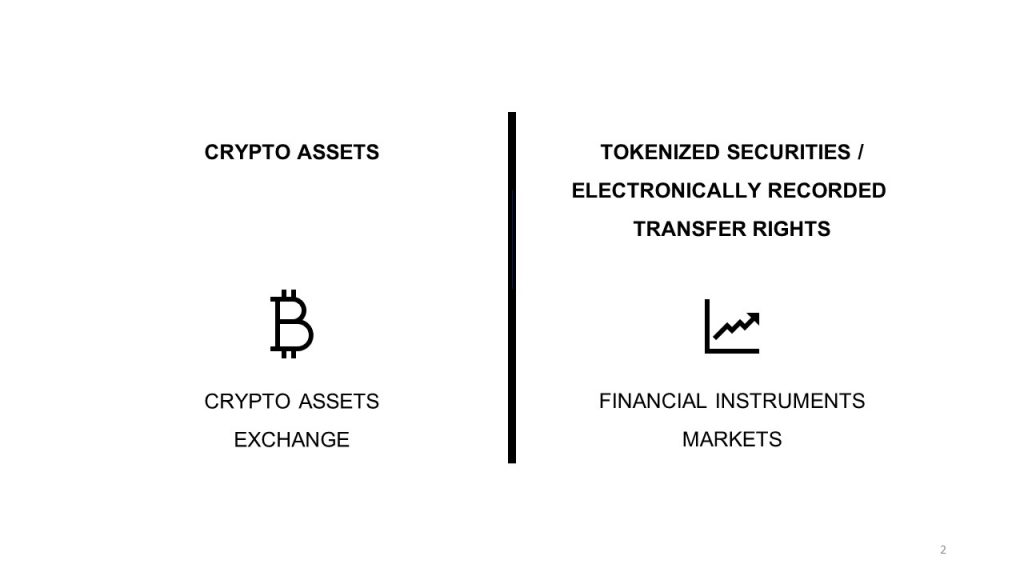
3.1 Utility tokens
3.1.1 Crypto Asset Exchanges
Under the PSA crypto asset exchanges and other companies providing crypto asset exchange services must register as crypto asset exchange service providers with the FSA.[63] Crypto asset exchange services are defined broadly and cover the following activities, provided they are carried out as a business:
- purchase and sale of crypto assets or exchange with other crypto assets
- intermediary, brokerage or agency services for the purchase and sale of crypto assets or exchange with other crypto assets
- custody services for crypto assets[64]
Given the broad definition of crypto asset exchange services, not only crypto asset exchanges must register with the FSA but also other service providers engaging in crypto-related activities (for custody services see section 4.1 below).
Crypto asset exchanges must implement corporate governance and security systems that ensure fair dealing on the exchange and reduce operational risks. [65] This includes among others to
- establish and maintain a business management system
- comply with AML/CFT regulations
- eliminate relationships with anti-social forces
- ensure the protection of customers and their funds (e.g. segregation of funds, storing funds in cold wallets, and retaining own funds equivalent to the users’ funds held in a hot wallet)
- implement and maintain an information security management system
- prepare, submit, and maintain records related to crypto asset exchange services
- prohibit misleading advertisement and advertisement of speculative trading
- prohibit and report unfair trading practices (e.g. market manipulation)
- make prior notification to the FSA in case of changes (e.g. listing of new tokens, change of scope of crypto asset exchange services)
This list is not exhaustive, and further obligations arise under subsidiary legislation and self-regulation imposed by the Japanese Virtual Currency Exchange Association (JVCEA). The self-regulation rules by the JVCEA consistently extend existing regulations and specify in greater detail the obligations under the PSA and AML/CFT regulations.
Crypto asset exchanges and other service providers registered as crypto asset exchange service providers must not engage in activities related to security tokens. These activities are exclusively subject to the FIEA and require additional registrations/licenses.
Excursion: Listing of new tokens
Each token must be analyzed in detail before listing. Where a token violates laws or is likely to be used for criminal activities (incl. money laundering), it must not be listed.[66] This applies in particular for privacy coins for which transactions are anonymous or extremely difficult to track. The results of the analysis must be reported to the board of directors and eventually to the JVCEA.[67] In cases in which the JVCEA does not approve the listing, the respective token must not be listed.[68] The listing of the new token must further be notified to the FSA prior to the token being listed.[69]
Excursion: Margin trading
Crypto asset exchanges providing leverage must inform their users about the risks of margin trading, circuit breakers (if any), as well as the deadline and modalities of repayment.[70] For retail investors, the leverage must not exceed 2x.[71] For corporate clients, there is no fixed maximum leverage. Instead, the ratio may be determined independently by the respective exchange based on a quantitative calculation model or by the JVCEA.[72] Crypto asset exchanges that do not wish to use these ratios may alternatively use the standard leverage of 2x for corporate clients as well.[73] Security deposits may be paid both in fiat and crypto assets. The amount required as a security deposit is calculated each business day.[74] In case of deficiencies, additional payments must be made within 48 hours from the time detecting the deficiency.[75]
Crypto asset exchanges lending fiat to their users must additionally apply for a money lending license under the Money Lending Business Act.[76] Exchanges lending crypto assets do not have to apply for such license.
3.1.2 OTC trading
Given the broad definition of crypto asset exchange services, OTC desks generally seem to be regulated under the PSA at first sight. This applies to both principal desks and agency desks. A closer look at the definition of crypto asset exchange services reveals however, that this is not necessarily the case.
Principal desks: Principal desks buy and sell crypto assets in their own name and on their own account and become counterparty to each transaction. Exchanging crypto assets into fiat currencies and vice versa generally falls under buying and selling of crypto assets as defined in the PSA. The same is true for exchanging crypto assets with other crypto assets.
Agency desks: Agency desks do not become a counterparty to transactions. Rather they act as pure intermediaries and broker deals on behalf of their clients. Such activities constitute intermediary services that are generally covered by the PSA.
The reason why many OTC activities are excluded from the registration requirement under the PSA is that those activities are not performed ‘in the course of business’ as interpreted by the FSA. While the term is generally interpreted broadly, it only covers situations in which the respective party faces the public, i.e. an unspecified large number of people, and does so with a certain continuity.[77] Whether this is the case must be determined on a case-by-case basis. Depending on the facts and circumstances of each case, OTC desks may or may not be covered by the definition of crypto asset exchange services. Engaging in trades with one or a few registered crypto asset exchanges does generally not trigger the license requirement under the PSA. A one-size-fits-all solution does, however, not exist.
3.1.3 Professional Traders / Market Makers / Liquidity Providers
Trading activities of professional traders and market makers do not constitute crypto asset exchange services under the PSA. This is due to the fact that proprietary trading is not considered a purchase or sale of crypto assets as a business under the PSA. The reason for this is that the PSA aims to regulate certain activities that pose a risk to the public. It does, however, not intend to regulate all activities related to crypto assets. Trading on regulated exchanges does not pose additional risks to the public and does therefore not fall within the ambit of crypto asset exchange services under the PSA.
3.2 Security tokens
The trading of security tokens on secondary markets is a problem not solved yet. While crypto asset exchanges typically have the infrastructure, they are not allowed to list security tokens on their exchanges. Regulated exchanges, OTC markets, and proprietary trading systems (PTS), as defined in the FIEA, on the other hand, are permitted to trade security tokens but currently lack the required infrastructure.
3.2.1 Exchanges for tokenized securities and electronically recorded transfer rights
The FIEA defines a financial instruments market as a market for the purchase and sale of securities and market derivatives.[78] Accordingly, the definition comprises markets for tokenized securities and electronically recorded transfer rights as defined in section 1.2 above. Persons who intend to operate a financial instruments market must obtain a license by the FSA.[79] Something different only applies to the operators of OTC markets and PTS.
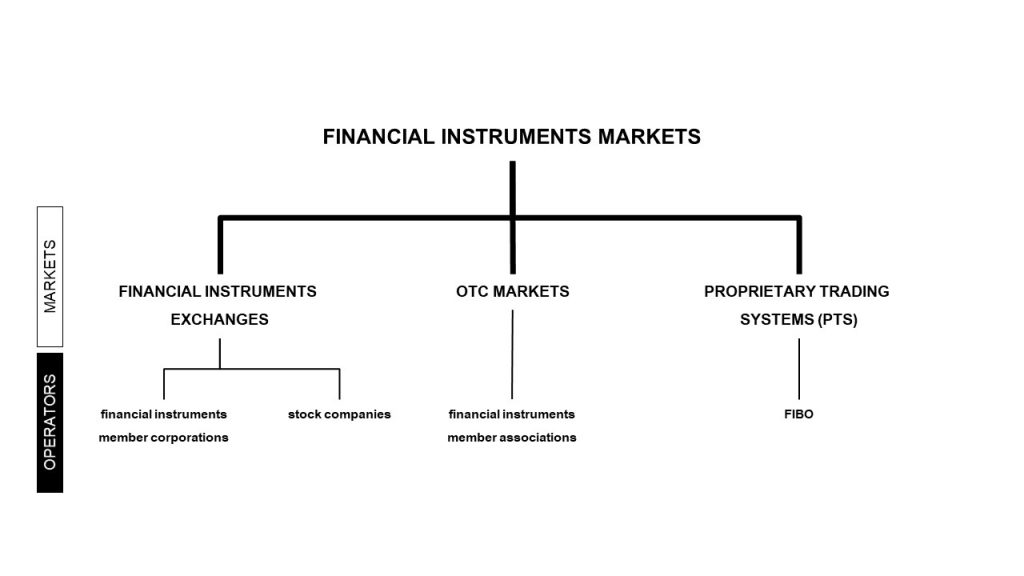
Financial Instruments Exchanges: Under the FIEA, a financial instruments exchange may only be established and operated by (i) a financial instruments membership corporation or (ii) a stock company.[80]
A financial instruments member corporation is a legal entity established by a FIBO to operate a financial instruments exchange. Membership in financial instruments member corporations is restricted to FIBOs only.[81] If the number of members falls below six members, the financial instruments member corporation must be dissolved.[82] The same applies if the corporation is not granted a financial instruments exchange license by the FSA.[83] Unlike financial instrument exchanges established by stock companies, exchanges established by financial instruments member corporations may not be operated for profit.[84]
Stock companies establishing a financial instruments exchange must have a stated capital of at least JPY 1 billion.[85] Shareholders are generally prohibited from holding 20 percent or more of the total voting rights.[86]
Out of the five stock exchanges in Japan, two are established as financial instruments member corporations – namely the Fukuoka Stock Exchange (FSE) and the Sapporo Securities Exchange (SSE) – and three as stock companies. The latter comprise the Tokyo Stock Exchange (TSE), the Osaka Stock Exchange (OSE), and the Nagoya Stock Exchange (NSE).
None of the existing exchanges has expressed the intention to establish an exchange for tokenized securities and electronically recorded transfer rights so far. Since this is unlikely to change any time soon, this opens opportunities for challengers in the digital assets space.
OTC Markets: For securities not listed on a financial instruments exchange, the FIEA provides that these securities may be traded on an OTC market established by an authorized financial instruments firms association (SROs).[87] SROs are incorporated by FIBOs as general incorporated associations[88] to ensure fair and orderly trading of securities and derivatives as well as to protect investors[89]. To be recognized as an SRO, the association must be authorized by the FSA.[90] Only then it may carry out the self-regulatory functions laid down in the FIEA[91] and operate an OTC market. Membership in an SRO is limited to FIBOs.[92] Similar to financial instruments exchanges operated by financial instruments member corporations, OTC markets must not conduct business for profit.[93]
Under the FIEA, SROs operating an OTC market are required to register the class and issues of securities traded on the OTC market and make a copy of the register available for public inspection.[94] The SRO must further disclose the trading volume and other particulars for each trading day and issue to its members and the public and report the same to the FSA.[95]
Securities traded on an OTC market may only be traded among the members of the SRO either on their own account or as intermediaries.[96] Depending on its articles of incorporation, an SRO may prohibit its members from taking purchase orders other than from professional investors.[97]
Currently, the only eligible SRO, the Japanese Securities Dealers Association (JSDA), does not operate an OTC market. The Japan STO Association, which currently applies to become the SRO for security tokens and comprising of six major Japanese brokerages, has not expressed the intention to operate an OTC market for tokenized securities or electronically recorded transfer rights yet.
PTS: PTS are similar to Alternative Trading Systems (ATS) in the U.S. and Multilateral Trading Facilities (MTF) in the EU. They were introduced in 1998 to improve investor confidence through competition and to respond to investor demands for more options. Until then, listed securities could only be traded on financial instruments exchanges.
A person operating a PTS conducts financial instruments business within the meaning of the FIEA[98] and must, therefore, register as a type I FIBO with the FSA.[99] According to the FIEA, the prices for securities traded on the PTS must be determined by one of the following methods[100]:
- methods that use the trading price of securities listed on a financial instruments exchange
- methods that use the trading price published by the financial instruments dealer association for securities traded OTCmethods that use the price negotiated by buyer and seller
- methods that use prices indicated by a buyer and a seller and that match corresponding orders[101]
- methods by which the operator of a PTS offers ask or bid prices on its own or through price feeds of other FIBOs excluding such cases in which the FIBOs are legally obliged to constantly quote bid and ask prices (so-called market-making method)[102]
- double auction methods
For PTS using a double auction method for price discovery, there are certain restrictions. According to the Enforcement Order, the average daily trading volume of listed securities on PTS may not exceed a certain percentage of the average daily trading volume on all financial instrument exchanges and OTC markets. Broadly speaking, the threshold is 1 percent of the total average daily trading volume for all securities listed on a financial instruments exchange or OTC market[103] and 10 percent of the total average trading volume for single securities listed on a financial instruments exchange or OTC market[104]. PTS exceeding these thresholds must apply for a financial instruments exchange license.
Given the fact that there are no security token markets which are operated by financial instrument exchanges or OTC markets, it is unclear whether PTS can only determine the prices of security tokens in accordance with the methods described under in item (iii) to (v) above.
Discussions are still ongoing, and the outcome is not clear yet. The argument for making PTS subject to the existence of financial instruments exchanges and OTS markets – at least for the methods indicated under items (i), (ii), and (iv) – is that the legislator only intended to increase competition with existing markets, but not to establish an independent framework for secondary markets. In order to maintain a level playing field between traditional securities markets and markets for security tokens, the same must apply to security token markets. On the contrary, it can be argued that the legislator only wanted to prevent liquidity drainage from financial instruments exchanges. For securities not listed on one of the licensed exchanges, such risk does not exist. Unlisted securities, whether tokenized or not, may therefore be traded on PTS, provided of course, the company establishing the PTS complies with other requirements laid down in the FIEA. The same applies to OTC markets. Where none of them exist, the risk of liquidity drainage is effectively non-existent.
Allowing FIBOs to operate PTS would also be in line with developments in other jurisdictions, namely the U.S., where crypto companies have acquired ATS in the past to get access to the desired license and to operate secondary markets for security tokens. Provided, the FSA follows this approach, companies seeking to establish a trading platform for security tokens by way of PTS must register as FIBO or acquire a company already registered. Compared to obtaining the financial instruments exchange license, this would most likely be the way to go for most companies. It is reported that several securities companies intend to jointly establish a new PTS securities company in 2020.
3.2.2 OTC
Proprietary trading of securities, and therefore also of tokenized securities and electronically recorded transfer rights, does generally not constitute financial instrument business under the FIEA.[105] Something different applies, however, if the respective entity deals with an unspecified large number of people with a certain degree of continuity.
Intermediary services for OTC trading also fall under the definition of financial instruments business, so that it is necessary to register as a FIBO.
3.2.3 Professional Traders and Liquidity Providers
Proprietary trading on financial instruments exchanges and PTS is generally not regulated under the FIEA. This also applies to the vast majority of liquidity providers. An exception is made, however, for high-frequency traders[106] which are not subject to other registration requirements under the FIEA. These traders are required to register with the FSA.[107]
3.3 Derivatives
As indicated above, the FIEA distinguishes between market derivatives transactions and OTC derivatives transactions. Market derivatives transactions are such derivatives transactions that are conducted on a financial instruments market. The focus here will be on OTC derivatives transactions, i.e. derivatives transactions, which are performed on a bilateral basis.
Entities engaging in crypto derivatives transactions engage in the financial instruments business as defined in the FIEA[108] and must, therefore, register as a Type I FIBO[109]. An exception is generally made for entities engaging in crypto derivatives transactions with certain counterparties.[110] This includes among others derivative transactions with type I FIBO and qualified institutional investors as defined in the Cabinet Order on Definitions[111] (e.g. financial institutions, high-net-worth individuals). The same applies where the counterparties are equivalent to the aforementioned persons under the laws of another jurisdiction[112] or where the counterparty is a company with a stated capital of JPY 1 billion or more[113]. While this seems to be good news, crypto derivatives are explicitly excluded from the exemption.[114] Companies engaging in crypto derivatives transactions must therefore generally register with the FSA as a type I FIBO.[115] Something different only applies in cases where a FIBO, which conducts an OTC crypto derivatives business in Japan, executes cover transactions with a person engaging in the crypto derivatives business under the laws of another jurisdiction. Provided the foreign entity does not conduct the crypto derivatives transactions from Japan, it does not have to register as a type I FIBO in Japan.[116]
Except from this particular case, companies engaging in crypto derivatives must register as type I FIBO in Japan.
Excursion: Margin trading
The maximum leverage for crypto derivatives transactions is 2x for individuals.[117] For corporations, there is no maximum threshold.[118] Similar to margin trading on crypto asset exchanges, the ratio must be determined by the service provider on a case-by-case basis. In the absence of such a decision, the maximum leverage will be 2x for corporate clients as well.[119]
4. CUSTODY SERVICES – CUSTODIANS AND CRYPTO ASSET EXCHANGES
Crypto assets, tokenized securities, and electronically recorded transfer rights all rely on some form of public key cryptography. The person holding the private key corresponding to the public-key controls the assets. In most cases, the user does not hold the private key himself. Instead, he transfers the control to an exchange or a wallet service provider which introduces new risks. With the amendment of the PSA, the legislator responded to these risks. It is possible that the regulator will introduce similar obligations for security tokens in the future.
4.1 Crypto Assets
The term crypto asset management is understood broadly and covers any activity where a service provider controls the crypto assets of another party.[120] In cases in which the service provider holds the private key(s) of a user, and is able to initiate a transfer of the crypto assets, the services constitute crypto asset management services within the meaning of the PSA and are subject to registration.[121] Given the broad definition of crypto asset management services, the term does not only cover traditional custody solutions, but also certain types of wallets that manage their users’ private keys.
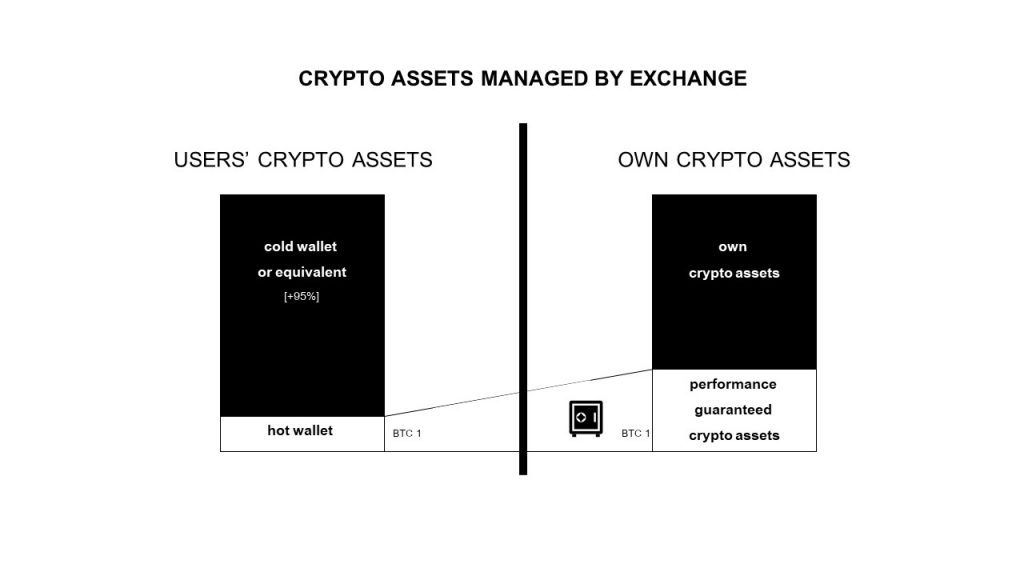
Crypto asset custodians as defined above must not only manage the crypto assets of their users separately from their own[122], but also separately from the other users’ assets to allow easy identification[123]. The private keys controlling the users’ crypto assets must generally be managed via devices which are permanently disconnected from the internet or by other methods that provide a similar level of security.[124] It is well possible that other solutions, such as multi-party computation (MPC), satisfy these requirements. Crypto assets which are held in hot wallets, i.e. where the private keys are stored on devices that are permanently connected to the internet, must be backed by the custodian’s own funds. Under the PSA, custodians are required to hold the same amount of the same crypto asset as their own assets in a cold wallet or in a wallet secured by a method providing a similar level of security, as the funds stored in a hot wallet. By way of example, if a custodian holds 1 BTC of the users’ funds in a hot wallet, it must hold the same amount of BTC as its own assets in a cold wallet. The maximum amount of users’ crypto assets which can be stored in a hot wallet is limited to 5 percent of the total assets under management.[125]
The same applies to crypto asset exchanges, which manage their users’ crypto assets. Additionally, exchanges may entrust their users’ crypto assets to a trust company. Since all of the registered exchanges are centralized exchanges, this applies to all of them. Decentralized exchanges may not have to fulfill these requirements depending on the degree of decentralization. For more information on the regulatory treatment of decentralized exchanges click here.
With respect to exchanges managing their users’ fiat money, they must store these funds separately from their own funds with a trust.[126] In case of insolvency, the funds, both crypto and fiat, are protected, and users of the crypto asset exchange are given priority over the other creditors.
4.2 Security tokens
For security tokens, no similar framework exists so far. It is likely that future subsidiary legislation will provide for similar regulations as for crypto assets – at least, in cases where a public blockchain is used. The risk of losing funds is likely smaller, however, since the token will be issued in a more controlled environment. Exchanges being hacked, may simply issue new tokens or ask the issuer to issue new tokens and put the stolen tokens/addresses on a blacklist.
5. CONCLUSION
Irrespective of whether a token is a crypto asset under the PSA, a tokenized security or an electronically recorded transfer right under the FIEA, the market is highly regulated in Japan. What seems to be a regulatory overkill, at first sight, is likely to help the market to mature in the mid to long term. This will allow more institutional players to enter the market and to increase their stake in the digital asset space. Companies that intend to operate on the Japanese market are well advised to analyze carefully whether their activities are regulated under Japanese laws. It should be noted that despite the tight regulations, there is still plenty of room for companies to operate on the Japanese market without a license. This is particularly true for companies that are licensed under the laws and regulations of other jurisdictions or who are willing to enter into strategic partnerships with licensed Japanese entities. For some companies, these entities might even become attractive takeover targets.
If you want to learn more or should you need legal or regulatory advice, please feel free to contact us directly under s.saito@innovationlaw.jp.
DISCLAIMER
This article contains a high-level overview and is prepared for general information of our clients and other interested persons. The content has not been confirmed by the relevant authorities, but merely contains information and interpretations that may be reasonably considered in accordance with the applicable laws and regulations. The opinions expressed in this article are our current views and may be subject to change in the future. This article is provided for your convenience only and does not constitute legal advice.
FOOTNOTES
[1] In this article cryptocurrencies, utility tokens, and investment tokens have the following meanings: (i) cryptocurrencies are tokens which are intended to be used as means of payment, (ii) utility tokens give token holders access to an application or service and often serve as a platform-internal currency, (iii) investment tokens allow token holders to participate in the profits of the issuer or the underlying network. Besides these pure forms, hybrid forms exist. The regulatory treatment of these hybrid tokens must be assessed carefully on a case-by-case basis and are therefore not covered by this article.
[2] To learn more about the regulatory treatment of stable coins under Japanese laws, click here.
[3] Article 2(5)(i) PSA.
[4] Article 2(5)(ii) PSA.
[5] Article 2(5) PSA.
[6] See Article 2(1) FIEA.
[7] See Article 2(2) FIEA.
[8] Article 2(3) FIEA.
[9] Ibid.
[10] See Article 9-2(1)(i) and Article 9-2(1)(ii) Cabinet Order on Definitions under Article 2 of the FIEA in connection with Article 17-12 Order for Enforcement of the FIEA.
[11] See Article 2(5) PSA.
[12] See https://jvcea.or.jp/cms/wp-content/themes/jvcea/images/pdf/statistics/2019
12-KOUKAI-01-FINAL.pdf.
[13] Article 2(24)(iii-2) FIEA.
[14] Article 2(20) FIEA.
[15] Article 2(21) FIEA.
[16] Article 2(22) FIEA.
[17] Article 2(2) FIEA in connection with Article 1-23 Order for Enforcement of the FIEA.
[18] I-I-2-2(5) Guidelines on Crypto Asset Exchange Business.
[19] For the definition of crypto asset exchange service see Article 2(7) PSA.
[20] Article 63-2 PSA in connection with Article 2(8) and Article 2(7) PSA; see also II-2-2-8-1 Guidelines on Crypto Asset Exchange Business.
[21] See also item 6 concerning Article 2 JVCEA Guidelines on the Sale of New Crypto Assets.
[22] Article 63-5(1)(i) PSA.
[23] Article 63-5(1)(iii) PSA in connection with Article 9(1)(i) Cabinet Order on Crypto Asset Exchange Service Providers.
[24] Article 25 Cabinet Order on Crypto Asset Exchange Service Providers.
[25] Article 63-5(iv) and (v) PSA.
[26] Article 63-11(2) PSA in connection with Article 27 Cabinet Order on Crypto Asset Exchange Service Providers.
[27] Article 63-11(1) PSA in connection with Article 26 Cabinet Order on Crypto Asset Exchange Service Providers.
[28] See Articles 107 et seq PSA.
[29] A list of all registered exchanges in Japan can be accessed under the following link https://www.fsa.go.jp/menkyo/menkyoj/kasoutuka.pdf.
[30] Article 4(1) JVCEA Rules for the Sale of New Crypto Assets.
[31] Article 4(2) JVCEA Rules for the Sale of New Crypto Assets.
[32] Article 4(4) JVCEA Rules for the Sale of New Crypto Assets.
[33] Article 4(5) JVCEA Rules for the Sale of New Crypto Assets.
[34] Article 63-6(1), 63-3(1)(vii) and (viii) PSA.
[35] Article 5(1) JVCEA Rules for the Sale of New Crypto Assets.
[36] Article 5(2) JVCEA Rules for the Sale of New Crypto Assets.
[37] Article 5(3) JVCEA Rules for the Sale of New Crypto Assets.
[38] Ibid.
[39] Article 6(2) JVCEA Rules for the Sale of New Crypto Assets.
[40] Article 6(1) JVCEA Rules for the Sale of New Crypto Assets.
[41] Article 6(4) JVCEA Rules for the Sale of New Crypto Assets.
[42] Article 6(5)-(7) JVCEA Rules for the Sale of New Crypto Assets.
[43] Article 9 et seq. JVCEA Rules for the Sale of New Crypto Assets.
[44] Article 15(1) JVCEA Rules for the Sale of New Crypto Assets.
[45] Article 15(3) JVCEA Rules for the Sale of New Crypto Assets.
[46] Article 18(1) JVCEA Rules for the Sale of New Crypto Assets.
[47] Article 18(2) JVCEA Rules for the Sale of New Crypto Assets.
[48] Article 18(3) JVCEA Rules for the Sale of New Crypto Assets.
[49] Article 15(5) JVCEA Rules for the Sale of New Crypto Assets.
[50] Article 17(1) JVCEA Rules for the Sale of New Crypto Assets.
[51] Article 17(2)-(5) JVCEA Rules for the Sale of New Crypto Assets.
[52] Article 15(6) JVCEA Rules for the Sale of New Crypto Assets.
[53] Article 16(1) JVCEA Rules for the Sale of New Crypto Assets.
[54] Ibid.
[55] See also item 3 concerning Article 1 JVCEA Guidelines on the Sale of New Crypto Assets.
[56] Article 2(3) FIEA, Article 1-5 Order for Enforcement of the FIEA.
[57] Article 4(1)(v) FIEA.
[58] Article 13(1) FIEA.
[59] Article 2(3) FIEA.
[60] Article 10 Cabinet Order on Definitions under Article 2 FIEA.
[61] Articles 28(2)(iii), 2(8)(vii) FIEA.
[62] Article 28(1) and 29 FIEA.
[63] Article 63-2 PSA.
[64] Article 2(7) PSA.
[65] Article 63-5(iv) and (v) PSA, Cabinet Order on Crypto Asset Exchange Service Providers.
[66] Article 4(1) JVCEA Guidelines on Handling Crypto Assets.
[67] Article 5 JVCEA Guidelines on Handling Crypto Assets.
[68] Article 4(2) JVCEA Guidelines on Handling Crypto Assets.
[69] Article 63-6, 63-3(3)(vii) PSA, Article 12(1) Cabinet Order on Crypto Asset Exchanges.
[70] Article 63-10(2) FIEA, Article 25 Cabinet Order on Crypto Asset Exchanges, II-2-2-2-2(1) Guidelines: Crypto Asset Exchanges.
[71] Article 25(4)(5)(i) Cabinet Order on Crypto Asset Exchanges, II-2-2-2-2(2)(i) Guidelines: Crypto Asset Exchanges.
[72] Article 25(4)(5)(ii) Cabinet Order on Crypto Asset Exchanges, Article II-2-2-2-2(2)(ii) Guidelines: Crypto Asset Exchanges.
[73] Ibid.
[74] II-2-2-2-2(2)(3) Guidelines: Crypto Asset Exchanges.
[75] II-2-2-2-2(2)(4) Guidelines: Crypto Asset Exchanges.
[76] Article 3(1) Money Lending Business Act.
[77] I-1-2-2(1) Guidelines: Crypto Asset Exchanges.
[78] Article 2(14) FIEA.
[79] Article 80(1) FIEA.
[80] Article 83-2 FIEA.
[81] Article 91 FIEA.
[82] Article 100(1)(iv) FIEA.
[83] Article 100(1)(vii) FIEA.
[84] Article 97 FIEA.
[85] Article 83-2 FIEA, Article 19 Order for Enforcement of the FIEA.
[86] Article 103-2 FIEA.
[87] Article 67(2) FIEA.
[88] Article 78(1) FIEA.
[89] Article 67(1) FIEA.
[90] Article 67-2(2) FIEA, Article 78(1) FIEA.
[91] Article 78(2) FIEA.
[92] Article 68(1) FIEA.
[93] Article 67-7 FIEA.
[94] Article 67 FIEA.
[95] Article 67(19) and 67(20) FIEA.
[96] Article 67(2) FIEA.
[97] Article 67(3) FIEA.
[98] Article 2(8)(x) FIEA.
[99] Articles 28(1)(iv), 29 FIEA.
[100] Article 2(8)(x) FIEA.
[101] Article 17(i) Cabinet Order on Definitions under Article 2 FIEA.
[102] Article 17(ii) Cabinet Order on Definitions under Article 2 FIEA.
[103] Article 1-10(i) Order for Enforcement of the FIEA.
[104] Article 1-10(ii) Order for Enforcement of the FIEA.
[105] For the definition of financial instruments business see Article 2(8) FIEA.
[106] For the definition see Article 2(41) FIEA, Article 26 Cabinet Order on Cabinet Order on Definitions under Article 2 FIEA.
[107] Article 66-50 FIEA.
[108] Article 2(8)(iv) FIEA.
[109] Articles 28(1)(ii), 29 FIEA.
[110] Article 1-8-6 Order for Enforcement of the FIEA.
[111] Article 1-8-6(1)(ii) Order for Enforcement of the FIEA in connection with Article 15(1) and Article 10 Cabinet Order on Definitions under Article 2 FIEA.
[112] Article 1-8-6(1)(ii) FIEA Enforcement Order in connection with Article 15(1) and Article 10 Cabinet Order on Definitions under Article 2 FIEA.
[113] Article 1-8-6(1)(ii) FIEA Enforcement Order in connection with Article 15(2) Cabinet Order on Definitions under Article 2 FIEA.
[114] Article 1-8-6(1)(i) FIEA Enforcement Order.
[115] See also IV-3-3-1(3) FIBO guidelines.
[116] Ibid.
[117] Art. 117(41) and (42) Cabinet Order on Financial Instruments Business.
[118] Art. 117(51) and (52) Cabinet Order on Financial Instruments Business.
[119] Art. 117(51) and (52) Cabinet Order on Financial Instruments Business.
[120] I-1-2-2(3) Guidelines on Crypto Asset Exchanges.
[121] Article 63-2 PSA in connection with Article 2(7)(4) PSA; I-1-2-2(3) Guidelines on Crypto Asset Exchanges.
[122] Article 63-11(2) PSA.
[123] Article 27(1)(i) Cabinet Order on Crypto Asset Exchanges.
[124] Article 63-11(2) PSA in connection with Article 27(3) Cabinet Order on Crypto Asset Exchanges; see also II-2-2-3-2(5) Guidelines on Crypto Asset Exchanges.
[125] Article 63-11(2) PSA in connection with Article 27(2) Cabinet Order on Crypto Asset Exchanges.
[126] Article 63-11(1) PSA in connection with Article 26 Cabinet Order on Crypto Asset Exchanges.

Cryptocurrency regulation in Japan is closely linked to the hack of the Japanese cryptocurrency exchange Mt. Gox in 2014 and Coincheck in 2018. As such, it is no surprise that the latest revision of the Payment Services Act (PSA) introduces detailed regulations on the safekeeping of crypto assets stored in hot wallets.
The impact of the new regulations depends on the exact business model of the cryptocurrency exchange. Before diving into the regulatory changes, their impact on the industry and potential solutions, we will therefore analyze the different business models in more detail.
1. Business models
Broadly speaking, cryptocurrency exchanges are centralized or decentralized. At present, all registered exchanges in Japan are centralized exchanges.
1.1. Centralized exchanges
An estimated 99 percent of trading volume occurs on centralized exchanges.[1] Centralized exchanges require users to transfer funds to an address controlled by the exchange. Until a user withdraws his funds from the exchange, he does not control the funds even though they are shown on his account.
Centralized exchanges host their own order books. Orders are matched and executed off-chain via proprietary matching and settlement systems.
1.2. Decentralized exchanges
Decentralized exchanges (DEX) allow users to trade crypto assets while remaining in full control over their funds throughout the transaction. Depending on the degree of decentralization DEX may further deploy on-chain order books and require users to manually identify and fill orders. To improve user experience and to overcome technological limitations related to full decentralization (e.g. latency of most public blockchains) most DEX use hybrid models. Typically, these models combine off-chain order books – and in some cases order matching – with on-chain settlement.
For the matching – in case of automatic order matching – and settlement users are required to transfer funds to a smart contract deployed by the DEX. The funds will only be used when orders are matched. Until then a user remains in full control and can withdraw his funds any time. At no point a DEX has control over the funds sent to the smart contract.[2]
While the architecture of DEX may vary considerably, DEX typically enable users to transact crypto assets without losing control over their funds.
2. Cryptocurrency exchange regulations
Japanese crypto regulations do not distinguish between centralized and decentralized models. Of legal relevance are only the actual activities, but not how they are structured.
Crypto exchange services under the Payment Services Act (PSA) include
- the purchase and sale of crypto assets (i.e. exchange between crypto assets and fiat currency) or the exchange with another crypto asset; and
- intermediary, brokerage or agency services for acts described under item (i).
Custody services are currently not regulated under the PSA. This will change under the new regulations which will enter into force early 2020. While the definition of custody services is somewhat unclear, we understand that only businesses managing their customers’ funds or controlling their customers’ private keys will be covered.
3. New requirements
Under the PSA both cryptocurrency exchanges and custodians must register with the Financial Services Agency (FSA).
In addition to the existing requirements the following additional compliance and reporting requirements will be introduced for registered exchanges:
- to establish and publish an incident report policy concerning the theft of crypto assets
- to hold crypto assets that are not less than the value of the customers’ crypto assets in hot wallets (if any) as the exchange’s own assets
- to put customers’ fiat into a trust
- to disclose financial statements publicly
- to publish OTC deals with customers (if any) as well as bid prices, ask prices, and bid-ask spreads for such OTC deals
- to refrain from making excessive advertisement, misrepresentations, cold calls, inadequate solicitations considering the customer’s knowledge, or advertisement and solicitations to induce speculative trading
- to notify the FSA of the intention to list new crypto assets for trading prior to such change taking place in order to exclude problematic crypto assets form listing
3.1. Exchanges
For exchanges that provide custody services, one must distinguish between funds stored in a hot wallet and such being stored in a cold wallet.
3.1.1. Hot wallet
Exchanges that hold parts of their customers’ funds in a hot wallet are required to hold the same amount of crypto assets as their own assets. By way of example, an exchange holding BTC 5 of its customers’ funds in a hot wallet must have BTC 5 as its own assets in a cold wallet. Maintaining an insurance policy that covers the crypto assets in the hot wallet is not sufficient under Japanese regulations.
Since the terms hot wallet and cold wallet are not defined in the PSA, we expect that subsidiary regulations and guidelines of the Japan Virtual Currency Exchange Association (JVCEA) – a self-regulatory body recognized under the PSA – will discuss the terms in more detail. It can be assumed, that the term cold wallet is interpreted in line with the general understanding that cold wallets are not connected to the Internet. Wallets that do not fall under this or a similar definition are likely to be considered hot wallets.
DEX are generally not affected by the new regulations, as they do not manage their users’ funds.[3] Instead, users remain in full control of their funds at all times. This also applies to funds which were transferred to smart contracts deployed by DEX for the execution of orders. Unlike funds in a hot wallet, these funds cannot be accessed or transferred by the DEX deploying the smart contract. Users, however, can withdraw their funds at any time. The fact that the use of smart contracts introduces new risks, including the risk of total loss due to the exploitation of bugs, does not lead to a different assessment. While the result of vulnerabilities, i.e the total loss of funds, is the same, the risks are fundamentally different from the risks stemming from the use of hot wallets. As such it is highly unlikely that smart contracts will be deemed hot wallets. Slight changes to the design of the smart contract may lead to different results however and should therefore be considered carefully.
3.1.2. Cold wallet
The new regulations require exchanges to hold most customers’ assets in a cold wallet. To ensure that all funds are readily available if an exchange fails, the funds stored in a cold wallet must be managed separately from the exchange’s own crypto assets.
Smart contracts deployed by DEX will most likely not be considered cold wallets. In fact, they are unlikely to be classified as wallets for regulatory purposes at all, unless they allow an exchange to access and control the funds stored in the contract address.
3.1.3. Fiat currencies
Unlike bank deposits, funds deposited at exchanges are not protected. To ensure similar results, exchanges in Japan are required to put fiat currencies of their customers in a trust.
Until today, all exchanges in Japan are centralized exchanges. To the best of our knowledge none of the DEX globally, provides a fiat gateway so far, so that applicants would not be affected by the new regulations.
3.2. Custodian Wallets
Other service providers such as custodian wallets that manage customers’ funds are also affected by the new regulations. This applies in particular with regard to funds stored in hot wallets. Where wallet service providers do not control their customers’ funds or private keys, it can be assumed that these providers are not subject to additional requirements.
4. Alternative structures
From our point of view, the most onerous burden for exchanges and custodians is most likely the one related to funds stored in a hot wallet. DEX provide clear advantages in that respect, but face challenges in other areas (e.g. scalability).
So, what are the alternatives for centralized exchanges? Shifting to a decentralized business model? Unlikely given the tradeoffs. Sacrificing customer experience for security and storing all funds in a cold wallet? Possible. Multisig or other solutions?
4.1. Multisig
While Multisig obviously provides enhanced security, it does not render a hot wallet a cold wallet. Something different might apply however, where the majority of keys is stored offline. It is our understanding that for a 2-of-3 Multisig at least two keys must be stored offline to be classified as a cold wallet. Except from enhancing security by eliminating unauthorized transactions through the misuse of a single key, Multisig does therefore not provide advantages over pure cold wallet solutions. In fact, it might even deteriorate customer experience by slowing down the transfer of funds in case a customer wishes to cash out.
4.2. Multiparty computation
Depending on the exact definition of hot wallets and cold wallets, multiparty computation (MPC) might provide a solution to the hot wallet problem. MPC ensures that the private key controlling the funds never exists in complete form in a single place. Instead, anyone participating in the MPC holds a fraction of the key which is constantly refreshed. If the promise that private keys never exist in complete form holds true, MPC might not even be considered a wallet. This would however only apply if the future definition of a wallet exclusively draws on the existence of a private key. It is much more likely that the subsidiary regulations and guidelines of the JVCEA ultimately draw on the control of funds. Where an exchange is effectively able to authorize transactions – irrespective of whether the keys exist in complete form or only as key shares – the provisions concerning custody services are triggered.
If the key shares are stored on devices permanently connected to the internet, it is likely that an MPC solution is considered a hot wallet. Where some of the key shares required for authorizing a transaction are stored on devices permanently disconnected from the internet an MPC solution is likely to be considered a cold wallet solution. Insofar reference is made to the explanations in respect to the Multisig solution in the previous paragraph.
In summary, MPC offers a smart and much-needed solution for cryptocurrency exchanges to increase both customer experience and security. Yet, it is unlikely be considered a cold wallet solution by design.
5. Conclusion
With the new regulations entering into force in April 2020, investors will see higher levels of protection in Japan. The improvements will most likely come at a price – higher compliance costs for exchanges or a deterioration of customer experience.
In an increasingly competitive environment smart solutions are much needed and likely to make a difference. MPC could be one of them. While much is still unclear, providers of MPC should therefore carefully assess how their solutions fit into the new regulatory environment. After all Japan is still one of the biggest markets for crypto assets worldwide.
We are going to update you, once the subsidiary legislation and guidelines from the JVCEA are published.
DISCLAIMER
This article contains a high-level overview and is prepared for general information of our clients and other interested persons. The content has not been confirmed by the relevant authorities, but merely contains information and interpretations that may be reasonably considered in accordance with the applicable laws and regulations. The opinions expressed in this article are our current views and may be subject to change in the future. This article is provided for your convenience only and does not constitute legal advice.
FOOTNOTES
[1] CircleResearch, Decentralized Exchanges (DEX), retrieved from http://research.circle.com/wp-content/uploads/2019/02/circle-research-decentralized-exchanges.pdf (accessed 19 July 2019).
[2] As can be seen from other decentralized apps (DApps) owners of DApps often exercise a certain degree of control over their smart contracts (e.g. pause of transfer, upgrade capabilities). For DEX, this type of control might directly translate into being subject to additional compliance requirements under the PSA and should therefore be analyzed carefully.
[3] Something different might only apply if DEX exercise control over the smart contract to which the funds are sent. Depending on the circumstances of the individual case, a smart contract might then be considered a hot wallet.

The most pressing questions and answers
1. What is a Security Token Offering (STO)?
There is no legal definition of STOs in Japan. STOs are however commonly understood as the issuance of digital tokens that constitute securities under the applicable laws in order to raise capital.
It should be noted, that the definition of securities varies from jurisdiction to jurisdiction.
For the purposes of this article security tokens are defined as digital tokens that have profit rights attached or which can be redeemed for more than 100 percent of the principal amount in money, virtual currencies or other assets.
2. What is the current market situation in Japan?
There have not been any public offerings of security tokens in Japan yet. There are cases however, in which companies sold security tokens to qualified institutional investors (QII) in a private placement. We expect increased activities once the amended Payment Services Act (PSA) and Financial Instruments and Exchange Act (FIEA) enter into force.
3. What is the current legal situation in Japan?
Under the current framework, STOs fall within the scope of the PSA and FIEA at the same time. As a result, persons involved in an STO must comply with both the PSA and FIEA.

3.1. Virtual Currency under the Payment Services Act
The Financial Services Agency (FSA) interprets the term virtual currency broadly. Tokens issued in an ICO are generally covered.
STOs are considered a type of ICOs. Tokens issued in a STO therefore fall under the PSA as well.
3.1.1. Registration as Virtual Currency Exchange Service Provider
The issuer of tokens must either register as Virtual Currency Exchange Service Provider or sell his tokens through one of the registered exchanges.
Registration is cumbersome and expensive. In the current environment, it is not realistic for token issuers to register as a Virtual Currency Exchange Service Provider.
At the moment it is also not possible to sell tokens through one of the registered exchanges. With the Japan Virtual Currency Exchange Association (JVCEA) publishing draft guidelines on ICOs, this is likely to change in the near future. Provided the guidelines are approved, token issuers will soon be able to sell their tokens via one of the registered exchanges.
Security tokens as defined in this article are explicitly excluded from the JVCEA guidelines.
3.1.2. Notification
Under the existing framework, registered exchanges must notify the FSA about the listing of new tokens. The notification has become a de facto approval by the FSA in practice. No tokens have been listed on registered exchanges since late 2017.
3.2. Securities under the Financial Instruments Exchange Act
Tokens without profit participation rights attached are generally not covered by the FIEA. Security tokens as defined under item 1 above may however be classified as securities under the FIEA. Security tokens that do not represent traditional securities such as shares or bonds may fall under the definition of collective investment schemes (CIS). To be classified as CIS all of the following requirements must be fulfilled:
- collection of money or money equivalent from others
- investment of the money in a business
- distribution of dividends to investors
Cases where tokens are issued in exchange for bitcoin or other cryptocurrencies instead of fiat currencies are not covered at present.
4. When will the new regulations enter into force?
In March this year, the Cabinet submitted a bill revising the PSA and FIEA to the Diet. The Diet approved the bill on 31 May 2019. With the amendments entering into force early next year, the term “virtual currency” will be replaced by the term “crypto assets” and regulations for registered exchanges will be tightened. In addition, Electronically Recorded Transfer Rights as defined in the FIEA will be explicitly excluded from the definition of crypto assets and exclusively be covered by the FIEA.
| Oct 2019 – end 2019 | FSA publishes Cabinet Order as subsidiary legislation and makes it available for public comment. Public comments and final orders will follow two to three months later (end of 2019 to March 2020). |
| ~May 2020 | Amended laws enter into force. |
5. What is the legal situation for security tokens after the amended laws enter into force?
After the amendments enter into force, most security tokens will exclusively be covered by the FIEA. Only in rare occasions, the PSA might apply at the same time.
5.1. What is the definition of security tokens under the new laws?
The legal term for security tokens under the new FIEA is Electronically Recorded Transfer Right. In order to classify a token as Electronically Recorded Transfer Right a token must fulfill all of the following requirements:
- rights listed in Article 2(2) FIEA (e.g. units in a fund, beneficial interests in a trust, membership rights in a general partnership, limited partnership or limited liability company)
- rights represented by proprietary value recorded electronically
- transfer by electronic means
- no case specified by Cabinet Order in consideration of liquidity constraints and other circumstances.
Tokens classified as Electronically Recorded Transfer Right are considered Type I Securities. The implications of such classification are discussed in further detail in the following sections.
In case any of the requirements from (2) to (4) are not fulfilled, a token is considered a type II security. Tokens for which the transferability is technically restricted may fall under the exemption in item (4) above. However, it is unclear at this point, which cases will be covered by the Cabinet Order.
5.2. Are tokenized shares or bonds also considered Electronically Recorded Transfer Rights?
No, tokenized shares or bonds are Type I Securities and not Electronically Recorded Transfer Rights under the FIEA. In practice, this does not make a difference however, since Electronically Recorded Transfer Rights are treated as Type I Securities. As such both are subject to the same disclosure requirements under the FIEA.
5.3. What is the relationship between Electronically Recorded Transfer Rights and crypto assets?
Electronically Recorded Transfer Rights are explicitly excluded from the definition of crypto assets under the amended Payment Services Act (PSA). Tokens that do not fall under the definition of Electronically Recorded Transfer Rights due to liquidity constraints may, in theory, be subject to both the PSA and FIEA. It must be noted, however, that in case of liquidity constraints, the token can also not be exchanged with other tokens or fiat currencies. As such, it is unlikely that the token is considered a crypto asset under the PSA.
5.4. Are there any disclosure requirements for Electronically Recorded Transfer Rights?
Electronically Recorded Transfer Rights are considered Type I Securities under the FIEA. As such they are generally subject to disclosure requirements at the time of issuance (e.g. registration documents, prospectus) and subsequently (e.g. quarterly reports, extraordinary reports).
The exact information that must be disclosed at the time of offering will be stipulated by Cabinet Order in the future. In general, the preparation of a prospectus and other disclosure documents takes a considerable amount of time.
5.5. Are there any exemptions from the disclosure requirements?
Private placements are generally exempted from disclosure requirements.
5.6. What is a public offering and what is a private placement?
A public offering is an offering of newly issued Type I securities to at least 50 persons which is not considered a private placement.
The following offers are considered private placements of Type I Securities under the FIEA:
- offers to qualified institutional investors (QII) only
- offers to specified investors only
- solicitations to a small number of investors (less than 50)
Private placements to QII: Offers to QII with the resale restriction under 5.7 below are considered private placements under the FIEA.
Private placements to specified investors: Offers to specified investors with the resale restriction under 5.7 below are considered private placements under the FIEA. Offers to specified investors other than QII can only be made by financial instruments business operators (FIBO).
Private placements to a small number of investors: Solicitations to less than 50 investors (QII can be excluded from this number) with the resale restriction under 5.7 below are considered private placements under the FIEA.
5.7. Are there any resale restrictions for securities acquired in private placements?
Private placements to QII: In general securities acquired in a private placement may not be resold to persons other than QII. The exact nature of the restrictions varies depending on the type of securities. In case securities are sold in violation of the restrictions on resale, the issuer must file a registration statement with the FSA.
Private placements to specified investors: In general securities issued in a private placement to specified investors may not be resold to other persons than specified investors. Where securities are sold in violation of these restrictions, the issuer must file a registration statement with the FSA.
Small number of investors: Resale restrictions vary depending on the type of securities. While there are no resale restrictions for shares, restrictions apply to the resale of share options and other securities. In these cases, the securities may only be transferred in bulk. Where the total number of units is less than 50, the units may not be split.
5.8. Do the same resale restrictions apply to security tokens?
In general, the same restrictions apply. Security tokens are considered “other securities” under the current FIEA Enforcement Order and Cabinet Order to which the same resale restrictions apply in case of private placements. It is possible that additional requirements, such as the implementation of technical measures, will be introduced in the future.
5.9. Are there any regulations for the handling of security tokens in Japan?
A person engaging in the business of buying and selling security tokens (incl. the provision of intermediary services, public offerings and private placements) must generally register as a FIBO under the FIEA.
5.10. Do we also have to register as a FIBO if we only sell our own security tokens?
There are no restrictions for the self-solicitation of tokens that are classified as traditional type I securities such as stocks. Regulations apply however for the self-solicitation of units in a CIS. Persons offering their own security tokens, which qualify as units in a CIS, must register as type II FIBO even if such units are considered Electronically Recorded Transfer Rights.
5.11. Are there any regulations related to the trading of security tokens?
Intermediaries in the sale and purchase of security tokens must register as type I FIBO. This applies irrespective of whether the tokens are classified as traditional type I securities or Electronically Recorded Transfer Rights.
Persons intending to operate a security token exchange must obtain a Financial Instrument Market License or the approval as proprietary trading system (PTS), depending on the business model. Since it is difficult to obtain the said license or to registers as PTS, we expect that most of the secondary trading will initially occur OTC.
6. Can tokens represent rights in an anonymous partnership and if so can these rights easily be transferred by transferring the tokens?
Under the Japanese Civil Code the transfer of contractual rights generally requires an agreement between the assignor and assignee as well as the consent of the counterparty to the contract. This should be reflected in the contract documentation for the STO.
7. Do the provisions of the Companies Act apply to the issuance of Electronically Recorded Transfer Rights?
Electronically Recorded Transfer Rights are not stock or bonds. The provisions on the issuance of stock and bonds under the Companies Act do therefore not apply. If the rights of an anonymous partnership or other funds are tokenized, an approval by the general meeting of shareholders is not necessary. Since the tokenization of an anonymous partnership can be considered an important decision a board resolution is however required.
8. Must a company obtain approval from its shareholders prior to issuing security tokens?
No, this is not necessary. From a management perspective, it is advisable to issue only tokens that do not harm the rights of existing shareholders.
9. Are there any peculiarities for listed companies that intend to issue security tokens?
Listed companies must disclose the issuance of security tokens in a timely manner. What kind
of information must be disclosed should be coordinated with the respective exchange
DISCLAIMER
This article contains a high-level overview and is prepared for general information of our clients and other interested persons. The content has not been confirmed by the relevant authorities, but merely contains information and interpretations that may be reasonably considered in accordance with the applicable laws and regulations. The opinions expressed in this article are our current views and may be subject to change in the future. This article is provided for your convenience only and does not constitute legal advice.
